- svg]:fill-accent-900">

Welcome aboard the world’s first hydrogen fuel cell superyacht
By Andrew Paul
Posted on May 7, 2024 11:13 AM EDT
Superyachts are notoriously dirty luxury toys , with a single billionaire’s boat emitting as much as 7,020 tons of CO2 per year. And while it’s unlikely uber-wealthy shoppers are going to forgo from their statement vessels anytime soon, at the very least there’s now a chance to make superyachts greener. That’s the idea behind the new Project 821 , billed as the world’s first hydrogen fuel cell superyacht.
Announced over the weekend by Danish shipyard cooperative Feadship, Project 821 arrives following five years of design and construction. Measuring a massive 260-feet-long, the zero-diesel boat reportedly sails shorter distances than standard superyachts on the market, but still operates its hotel load and amenities using completely emissionless green hydrogen power.
Hydrogen cells generate power by turning extremely lightweight liquid hydrogen into electricity stored in lithium-ion batteries. But unlike fossil fuel engines’ noxious smoke and other pollutants, hydrogen cells only emit harmless water vapor. The technology remained cost-prohibitive and logistically challenging for years, but recent advancements have allowed designers to start integrating the green alternative into cars , planes , and boats .
There are still hurdles, however. Although lightweight, liquid hydrogen must be housed in massive, double-walled -423.4 degrees Fahrenheit cryogenic storage tanks within a dedicated section of the vessel. According to Feadship , liquid hydrogen requires 8-10 times more storage space for the same amount of energy created by diesel fuel. That—along with 16 fuel cells, a switchboard connection for the DC electrical grid, and water vapor emission vent stacks—necessitated adding an extra 13-feet to the vessel’s original specifications. But these size requirements ironically makes superyachts such as Project 821 arguably ideal for hydrogen fuel cell integration.
And it certainly sounds like Project 821 fulfills the “superyacht” prerequisites, with five decks above the waterline and two below it. The 14 balconies and seven fold-out platforms also house a pool, Jacuzzi, steam room, two bedrooms, two bathrooms, gym, pantry, fireplace-equipped offices, living room, library, and a full walkaround deck.
Such luxuries, however, will need to remain relatively close-to-harbor for the time being. Project 821 still isn’t capable of generating and storing enough power to embark on lengthy crossings, but it can handle an “entire week’s worth of silent operation at anchor or [briefly] navigating emission-free at 10 knots while leaving harbors or cruising in protected marine zones,” according to Feadship.
[Related: This liquid hydrogen-powered plane successfully completed its first test flights .]
“We have now shown that cryogenic storage of liquified hydrogen in the interior of a superyacht is a viable solution,” Feadship Director and Royal Van Lent Shipyard CEO Jan-Bart Verkuyl said in the recent announcement, adding that “additional fuel cell innovations… are on the near horizon.”
Of course, the greenest solution remains completely divesting from ostentatious, multimillion-dollar vanity flotillas before rising sea levels (and angry orcas ) overwhelm even the wealthiest billionaires’ harbors. But it’s at least somewhat nice to see a new eco-friendly advancement on the market—even if it still looks like a Bond villain’s getaway vehicle.
- Yachting World
- Digital Edition

How hydrogen fuel cells could provide a truly clean energy source for yachts
- December 16, 2020
Rupert Holmes investigates the latest hydrogen fuel cells and asks if they could provide a clean electrical power source for yachts

Phil Sharp demonstrating hydrogen fuel cell technology aboard his Class 40 OceansLab. Photo: Olivier Blanchet
Nearly a decade ago there was plenty of talk about hydrogen fuel cells becoming the carbon-free future for the automotive industry, yet we rarely hear about it now. So what happened?
There are a number of reasons, including lower initial costs for battery powered vehicles in the early part of the electric vehicle revolution, and the high cost of platinum needed as a catalyst for fuel cells, which put the brakes on their adoption.
However, there are currently huge environmental and human costs in mining the cobalt used in lithium ion batteries – one of a number of factors that will make it difficult to scale existing technology up to several multiples of today’s level of production.

Test bed installation of a Genevos HPM-8 fuel cell. Photo: Gilles Delacuvellerie
Much hope for the future is pinned on improved battery chemistry and eye-watering amounts of money are being poured into this, but any potential game changing developments are still at the research stage and remain some way from becoming a commercial reality.
Lack of media attention, however, has not slowed the development of hydrogen power, which is widely seen as being easier to quickly scale up to many times the current level of production than battery power.
In October this year the French government, for instance, announced a €7 billion commitment to create 6.5 gigawatts of hydrogen power capability by 2030. That’s equivalent to the total output of all six gas turbine power stations commissioned in the UK in the last decade.
Article continues below…
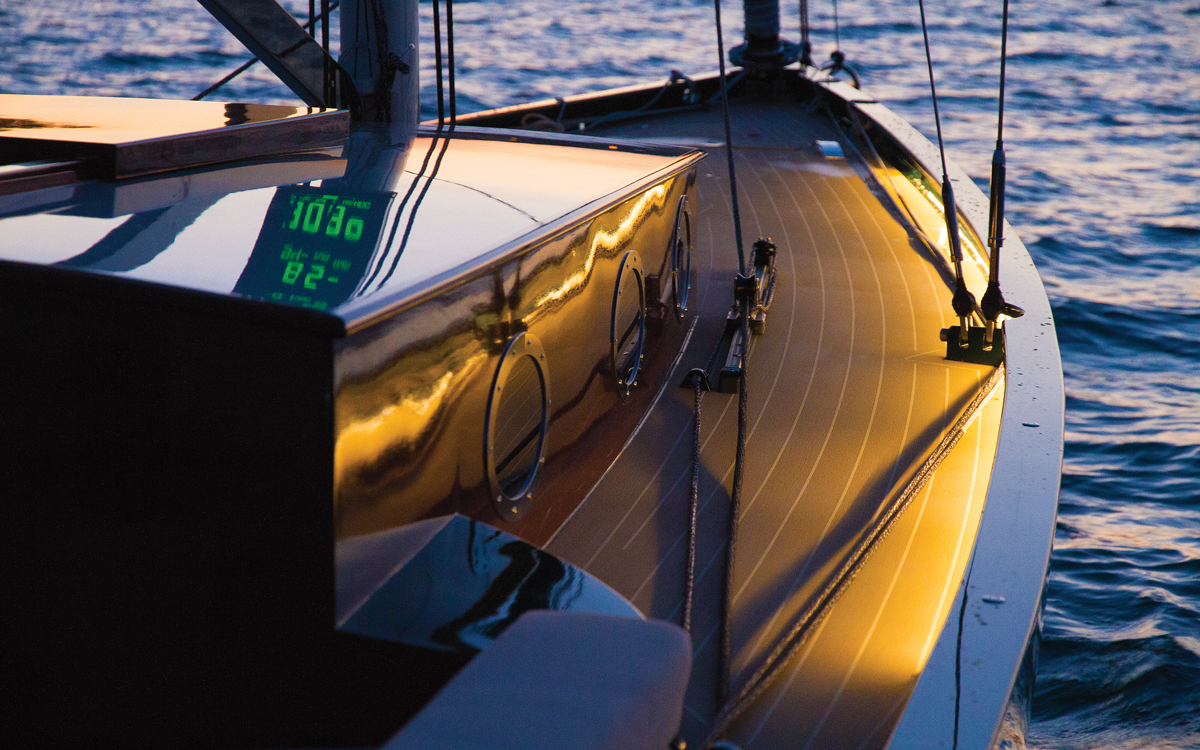
How hybrid sailing yachts finally became a feasible option
Every sailor is familiar with the wet cough of the diesel engine, and the acrid smell of its exhaust. For…

Lithium boat batteries: Why now is the right time to upgrade your electrics
Larger new cruising yachts, especially those at the quality end of the market, have been routinely fitted with lithium boat…
Equally, American engine and power plant manufacturer Cummins has a 20 year history of developing hydrogen fuel cells. Its latest move, announced in September, was the acquisition of hydrogen generation and fuel cell manufacturer Hydrogenics in a US$290 million deal. At the same time, infrastructure for hydrogen is improving across Europe, albeit from a low base, and BMW, Toyota and Hyundai all have hydrogen powered cars in the pipeline.
Hydrogen fuel cells are no longer technology that will become available at some unspecified time in the future – they’re here today. Canadian fuel cell specialist Ballard Power Systems, for instance, has already supplied systems for vehicles that have travelled a cumulative 20 million miles.
Why is this relevant to sailing? The leisure marine industry is tiny by comparison to other sectors, so doesn’t have the resources to develop technologies from scratch. However, good ideas from other fields can be adapted and harnessed for use on board.
Green hydrogen
Hydrogen gas is in effect stored energy and therefore requires a significant energy input to create it. The production of green (ie. eco-friendly) hydrogen therefore requires renewable sources of electricity such as wind and solar and can be rapidly ramped up and down to smooth peaks and troughs in the output.

Genevos HPM-8 fuel cell system is housed in a composite module for protection against the harsh marine environment
Genevos HPM-8 hydrogen fuel cell
Successful solo offshore racer Phil Sharp is at the forefront of developing hydrogen fuel cells for yachts. His 8kW HPM-8 (Hydrogen Power Module) is of a size that will solve range problems for yachts of around 40ft with electric propulsion motors of up to 15kW.
“The idea is it will act as a significant range extender for boats with electric propulsion,” says Sharp. The standard battery bank can therefore be used for propulsion over short distances, such as entering and leaving port, and can be replenished with regeneration while sailing, via solar power or when next in port and connected to shore power. The hydrogen power can therefore be kept in reserve for motoring greater distances, such as sailing across the Channel when there’s no wind.
Equally, the HPM-8 is a suitable size for larger yachts to use as an auxiliary generator. Sharp started optimising this unit around the needs of the IMOCA 60 and Class 40 rules, with the idea that these vessels would provide excellent test beds and proof of concept for a rugged, marinised hydrogen fuel cell.

Offshore solo racer Phil Sharp has developed the Genevos HPM-8 fuel cell. Photo: Gilles Delacuvellerie
All components are neatly contained in a composite module, where they are protected from salt water that may cause corrosion and oxidisation. The unit is therefore a neat plug-and-play device, incorporating all the necessary control, cooling and ventilation elements, plus regulated battery charging that acts as an additional layer to the vessel’s own battery management system. It’s connected directly to the boat’s batteries and electric motors.
Typically the hydrogen cylinder will be a carbon fibre tank permanently fitted to the boat, in much the same way that LPG powered vehicles have a permanently fitted gas tank.
This standardised modular format also simplifies both installation and maintenance, making it easier for installers to become certified, which in turn improves after-sales service and helps allay safety concerns.
Output is 48V, which matches that of many electric drive units and can be easily scaled down to 12V or 24V if necessary, or indeed up to higher voltages. The stack has a lifespan rated at more than 10,000 hours of use, after which reconditioning/refurbishment is possible instead of outright replacement.
How hydrogen fuel cells work
The key to any fuel cell is this so-called ‘stack’ where the platinum catalyst separates hydrogen molecules into protons and electrons, thus creating a current between anode and cathode. The hydrogen combines with oxygen from air supplied to the stack to produce water – the only by-product of the process.
“Safety is always a primary concern,” Sharp told me when I visited him at EIGSI, the general engineering school of La Rochelle University, where the design of the unit was finalised and tested. “There are already a lot of stringent safety standards in place for hydrogen fuel cells on board ships,” he adds, “so we were able to use those as a reference for smaller vessels.”
He therefore believes the systems developed for the safety of onboard hydrogen fuel cells go beyond those used for gas systems on yachts. The HPM unit includes a hydrogen detector interfaced with a solenoid valve to automatically shut off the hydrogen supply at the tank in the event of a leak.
Sharp also points out that the hydrogen is so light that, unlike propane or butane, it wants to escape upwards providing there’s ventilation for an escape route. Even so, in the power module the wiring and contacts carrying high current are housed in a separate sealed compartment.
Even when made of carbon fibre, the hydrogen tank is heavy, weighing close to 100kg for a tank that will hold 6kg of hydrogen. However, when you consider the inefficiencies inherent in diesel engines, this tank has the equivalent useable energy to roughly 50 litres of diesel.
For a hydrogen fuel cell-powered boat, eliminating the weight of a diesel motor means the total system weight equals that of a conventional diesel powered vessel when fuelled for a 100-mile range, but is a whopping 65-70% lighter than the lithium-ion batteries that would be needed to motor that distance on a 40ft yacht.
The HPM-8 is currently going through the type approval process. When that’s complete in the early part of 2021 it will be manufactured in La Rochelle, where Sharp’s company Genevos has facilities and support on tap to quickly scale up production.
On the downside, as with other emerging technologies, until production volumes ramp up early units will be expensive. Depending on their location the lack of a comprehensive hydrogen grid may also be a problem for some users. However, the billions being poured into the infrastructure will rapidly change this over the next five years, in a similar manner to when LPG became readily available for road vehicles two or three decades ago.
A reality of being able to fill up a hydrogen tank on a boat, in a similar fashion to filling with petrol or diesel, is therefore closer than most of us expect. Sharp says the scale of investment is such that there will be a good green hydrogen network within the next five years.
Currently the retail cost of green hydrogen is around €10 per kilo. That may sound expensive, but then consider marine diesel engines are hugely inefficient, especially in smaller sizes. What’s more, a kilogram of hydrogen contains three times as much useable energy as a kilo of diesel.
Therefore at around €60 the fuel cost of motoring for 100 miles in a 40ft yacht with electric propulsion is already in the same ball park as diesel power and with costs of hydrogen fuel cells dropping rapidly it will not be long before the new technology is more economic.

Energy Observer has been trialling wing sail, solar and hydrogen fuel cell propulsion
Energy Observer Developments
Many other organisations are operating in this space. Frenchman Victorien Erussard, a former merchant officer and Offshore sailor (Route du Rhum, Transat Jacques Vabre), bought the Energy Observer , catamaran as a floating laboratory to demonstrate the potential of renewable power.
This project led to the formation of Energy Observer Developments, which has raised €20 million of seed funding to develop commercial products in the hydrogen sphere. It offers a fully marinised 80kW hydrogen fuel cell system designed in partnership with Toyota. Up to 10 of these can be linked together to produce an immense 800kW of power at 600V. The units can either be used as range extenders for propulsion applications or as silent emission-free generators for the hotel loads of superyachts and other vessels of similar size.
Energy Observer Developments has also developed a plug-and-play floating hydrogen refuelling dock that’s able to electrolyse up to 200kg of hydrogen fuel from water every day.

Toyota hydrogen fuel cell system
Ultimate vision
While it makes sense to start with a relatively small unit that’s optimised for the market and types of use with which Sharp is most familiar, his ambition is to play a role in decarbonising the shipping industry as a whole, since it has greater carbon emissions than aviation.
Larger units are already planned, with 30kW and 50kW modules scheduled for launch in late 2021 and a 200kW model in 2023. These will be proportionately less expensive than the HPM-8 as the price per kW of power output is substantially less for larger fuel cells. At the same time, as the industry expands and volumes grow, the very high component costs are forecast to rapidly reduce, which in turn will open the market up to a wider audience.
The initial focus, however, remains on getting the smaller units into the field. Sharp says he’s already talking to a large catamaran builder and builders of high speed ferries, but is still looking for partners in the sailing, motorboat and river taxi arenas. “Above all,” he says, “this is not tomorrow’s technology. It’s here today and we’re aiming to get it into the marine market as quickly as possible.”
Pricing of the HPM-8 will be announced when it’s launched in the spring of 2021.
Genevos HPM-8 specifications
Continuous power: 8kW Output: 48V Peak efficiency: 55% Expected lifespan: >10,000 hours Weight: 55kg Size: 900x650x300mm
This is Sharp’s racing and demonstration arm, which currently includes his successful Class 40 OceansLab (formerly Imerys ). Looking ahead, he is actively seeking partners to demonstrate the technology on an IMOCA 60 around the world. “Our mission is to stimulate the uptake of hydrogen technology in the marine sector,” he says. “We know it’s vital for decarbonisation and with these raceboats we can demonstrate it’s viable and reliable.”
First published in the December 2020 issue of Yachting World
- Hydrogen Fuel Cell
- battery-powered boat
- Hydrogen Boats
The US’s first hydrogen-fueled ship is officially ready to set sail
The Sea Change , a hydrogen-powered catamaran ferry, just got Coast Guard clearance to operate commercially in the Bay Area.
Maritime vessel developer SWITCH Maritime received US Coast Guard approval on Friday to operate its flagship hydrogen ferry, the Sea Change, as a public ferry service.
“We are immensely grateful for the support from the US Coast Guard and all our partners along the path to completion,” said Pace Ralli, CEO of SWITCH. “This is not the finish line, but just a starting point from which to build many more.”
The Sea Change is equipped with hydrogen fuel cells that power its all-electric motors. These cells allow the vessel to travel up to 300 nautical miles (345 miles) at speeds of up to 15 knots (17 mph) and don’t require shoreside charging infrastructure.
Built and launched at All American Marine shipyard in Bellingham, Washington, the Sea Change is a 75-passenger catamaran ferry featuring an integrated hydrogen power system from Zero Emission Industries that has 360 kW of fuel cells from Cummins and 600 kW of electric motor propulsion from BAE Systems.
Following a formal launch event in June, the Sea Change will be operated in a six-month pilot service by the San Francisco Bay Area Water Emergency Transportation Authority (WETA). It’s funded by a public-private sponsorship that includes the Golden State Warriors and a $3 million grant from the California Air Resources Board.
SWITCH Maritime will put the hydrogen ferry into a more permanent route when the pilot finishes. The company is also developing new designs for larger and faster ferries for San Francisco Bay and other major US and international ferry markets.
Read more: Toyota goes large on hydrogen with new US headquarters
If you’re an electric vehicle owner, charge up your car at home with rooftop solar panels. To make sure you find a trusted, reliable solar installer near you that offers competitive pricing on solar, check out EnergySage , a free service that makes it easy for you to go solar. They have hundreds of pre-vetted solar installers competing for your business, ensuring you get high quality solutions and save 20-30% compared to going it alone. Plus, it’s free to use and you won’t get sales calls until you select an installer and share your phone number with them.
Your personalized solar quotes are easy to compare online and you’ll get access to unbiased Energy Advisers to help you every step of the way. Get started here . –ad*
FTC: We use income earning auto affiliate links. More.


Michelle Lewis is a writer and editor on Electrek and an editor on DroneDJ, 9to5Mac, and 9to5Google. She lives in White River Junction, Vermont. She has previously worked for Fast Company, the Guardian, News Deeply, Time, and others. Message Michelle on Twitter or at [email protected]. Check out her personal blog.
Michelle Lewis's favorite gear

MacBook Air
Light, durable, quick: I'll never go back.

Because I don't want to wait for the best of British TV.

Manage push notifications

World’s First Hydrogen Boat Powered By Printed Circuit Board Fuel Cell Technology Completes Real-World Testing

- Funded by the Energy Entrepreneurs Fund, as part of the Net Zero Innovation Portfolio, the HyTime project completes real-world testing with lead partner Bramble Energy providing its revolutionary fuel cell system along with custom engine builder Barrus
- Bramble Energy has designed, developed and deployed a unique marinised fuel cell system for use within a narrowboat – a first of its kind application
- The project demonstrates Bramble’s printed circuit board fuel cell (PCBFC™) technology in a real-world environment, serving as a showcase of hydrogen’s vast potential to decarbonise the marine sector
- Offers a solution to replace diesel engines in boats which could potentially save 12 tonnes of CO2 annually per vessel
- The hydrogen-powered narrowboat will now begin a testing programme on UK inland waterways with data collected helping Bramble develop future marine PCBFC™s
- PCBFC™ technology provides a viable route for accessing the hydrogen economy as they can be manufactured in almost any size or arrangement at much greater speed and scale than traditional electrochemical stacks, at a much lower cost
Crawley, UK, 10 January 2023: Bramble Energy , an innovator and disrupter in fuel cell technology, has achieved a milestone in marine history by launching the world’s first hydrogen-electric boat powered by a printed circuit board fuel cell (PCBFC™).
As the lead partner in the HyTime project working alongside custom engine builder Barrus, Bramble Energy has created a demonstration vessel that showcases the vast potential of its PCBFC™ technology to quickly and cost-effectively decarbonise the marine sector.
In a maritime first, the 57ft narrowboat was launched onto the water in Sheffield, Yorkshire, where it has successfully completed testing, emissions-free, using a custom marinised fuel cell system. The fuel cell system has the potential to provide the vessel with approximately 600 miles of range using the 14kg of hydrogen stored on-board, as well as additional power being supplied from solar panels on the boat’s roof to the 22kWh battery system.
In 2022, Bramble Energy was awarded Government funding from BEIS, now the Department for Energy Security and Net Zero (DESNZ), of just under £1 million to develop its hydrogen fuel cell technology as a solution to replace diesel engines in boats. The integration and deployment of the technology represents the successful completion of the project between the partners.
The vessel, which has been built from the ground up, has been under construction in Sheffield where Bramble engineers have created a completely new design of a hydrogen system to meet marine requirements, and the boat has the potential to save each boat using this powertrain technology up to 12 tonnes of CO2 per year.
The global maritime sector contributes to 940 million tonnes of CO2 per year, equating to approximately 2.5% of global greenhouse gases. As such, the Clean Maritime Plan requires new vessels to be zero-emission capable from 2025. The project’s goal was to demonstrate how the shift to a hydrogen fuel source could help the transition thanks to providing a range extender to pure battery systems, but also to remove the reliance on a charging base.
Dr Tom Mason, co-founder and CEO of Bramble Energy commented : “While road transportation has arguably had the greatest amount of attention in terms of developing zero-emission solutions, the reality is there is a massive urgency to decarbonise across all transportation sectors – especially marine. CO2 emissions from the marine sector are staggering. It requires a quick, convenient, cost-effective technology that also provides no compromise when it comes to performance.
In a short amount of time we have designed, developed, built and launched a working demonstration of our PCBFC™ technology within a marine application. Our solution has the ability to meet a range of power needs and is easily scalable, which is the exact catalyst the industry needs to make a seamless shift to hydrogen to quickly meet emissions regulations and contribute to greener and cleaner waterways.”
With the fuel cell stack successfully integrated into the narrowboat, it has now completed a comprehensive testing programme on UK inland waterways. Now, at its world-leading Hydrogen Innovation Hub in Crawley, the Bramble Energy team will analyse the boat’s data along with vital information about the fuel cell’s performance under real-world conditions. This analysis will support the future development of PCBFC™ systems for wider maritime applications.
About Bramble Energy
Bramble Energy is powering a Net Zero world – today – and is proving to be a real game changer in solving key challenges in the production of hydrogen fuel cells including: lead times, up-front investment, manufacturing cost and scalability.
Co-founded in 2016 by Dr Tom Mason in the research labs at Imperial College of London and University College of London, Bramble Energy through revolutionary fuel cell design and manufacturing techniques, has developed the unique printed circuit board (PCB) fuel cell – the PCBFC™. A patent protected fuel cell that can be manufactured in almost all printed circuit board (PCB) factories worldwide.
Bramble is fast becoming the leading hydrogen fuel cell provider for a cleaner and more sustainable world. Home for Bramble Energy is a state-of-the-art facility in Gatwick, UK, where they have launched their portable power product range and are developing their high-power density, liquid-cooled fuel cell systems under the same scalable low-cost technology platform.
For more information about Bramble Energy visit: https://www.brambleenergy.com/
The World’s First Type Approved Fuel Cell Engine Powering the Next Generation of Zero-Emission Vessels
For ship owners and operators globally, zero-emission mandates and regulations are a fast-approaching reality in an industry which currently accounts for 3% of the world’s GHG emissions. However, with a worldwide commercial fleet of more than 90,000 ships, “going green” is not an easy task.
To date, the pace of decarbonization has largely depended on new and emerging technologies, often involving long development time, proof of concept and pilot testing. This is where Ballard’s FCwave™ fuel cell module is breaking new ground. The module is the world’s first to be awarded Type Approval for marine applications, an industry recognition certifying that FCwave™ meets the stringent safety, functional, design and documentation requirements that are required for global marine commercialization.

As the first commercially available solution, it is a significant step in accelerating the adoption of hydrogen-power for ships and larger vessels and provides ship owners and operators confidence in fuel cells as the most viable, zero-emission technology.
Here, you’ll learn more about Ballard’s FCwave™ – a direct replacement for conventional marine internal combustion power systems – which was recently certified by DNV , one of the world’s leading classification agencies, as the first implementation ready solution for the next generation of zero-emission vessels.
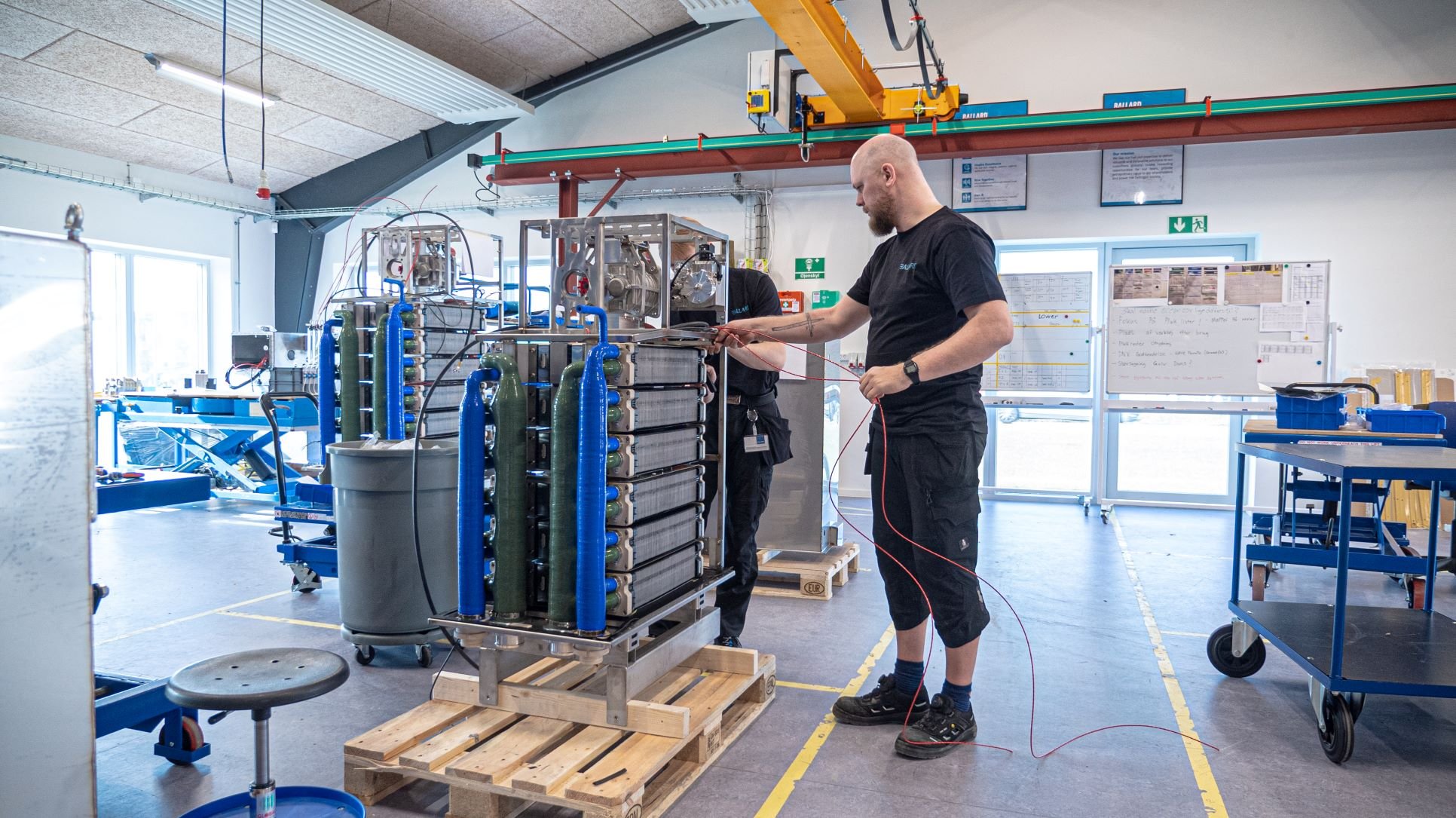
Fuel cells are ready to take center stage in marine applications
The first fuel cells are already beginning to prove their value at sea and at ports , currently powering a number of smaller vessels and port handling equipment. Before the end of 2022, FCwave™ will feature on Norled A/S’s MF Hydra – the world’s first liquid hydrogen-powered ferry. Taking the leap into commercial passenger operations with one of Norway’s largest ferry operators, the MF Hydra will be powered by two 200kW FCwave™ modules as Norled launches the first zero-emission passenger experience on Norway’s world heritage fjords. The technology is now being harnessed for use in larger ships where hydrogen and FCwave™’s long range, fast refueling, uncompromised performance, fuel efficient, and lower maintenance costs are an attractive proposition for vessels operating over longer distances or duty cycles where battery-power falls short.
But how do fuel cells work onboard a ship, boat, or ferry?
Hydrogen fuel cells are compatible with modern electric and hybrid architectures – and they generate the electricity that powers the vessel. Like batteries, they produce electricity, but with fuel cells, hydrogen fuel is the energy carrier – meaning the power system will produce electricity for the vessel for as long as hydrogen is available. FCwave™ is a high-power, adaptable power generator in a hybrid electric system that incorporates fuel cells and batteries working seamlessly together to deliver efficient, zero-emission power.
The modular design of fuel cells facilitates easy and adjustable deployment, which integrators can configure for specific vessel requirements. They provide long range operation, with consistent power delivery throughout the duty cycle. Refueling is fast , and fuel cells are proven, in many critical heavy-duty applications, to be reliable, with a long service life and few maintenance intervals.
Type Approval means marine fuel cell technology is now the most viable route to zero-emissions

FCwave™ unlocks fuel cell power for vessels operating across a wider range of routes and applications through a certified commercial solution that enables faster implementation and deployment, paving the way for volume applications.
Benefits include:
- For ship owners, FCwave™ offers ease of integration, reduced development time and cost
- For operators, FCwave™ is the first power solution that is deployment-ready in scale and volume, from individual vessels to fleets
- Hydrogen is as safe as other fuel and energy sources, and can be stored as a liquid or gas in large containers for flexible refueling at docks
Including hydrogen fuel cells in your technology considerations
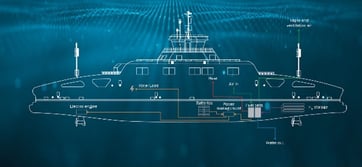
Do you want to know more about Ballard’s zero-emission fuel cell marine solution? Get in contact with our fuel cell experts today.
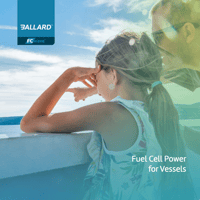
FCwave™: Fuel Cell Power for Marine Vessels
Discover the future of zero-emission marine vessels with Ballard's marine fuel cell module, FCwave™ No email required.

Related posts

Hydrogen fuel cells for zero-emission cold ironing
Stringent environmental regulations are affecting the marine industry at a fast pace and with the...

H2Ports: future proofing with fuel cells
Over 80% of the volume of international trade is carried by sea and port terminals, contributing...

Demonstrating zero-emission port vehicles at the Port of Valencia
On November 28, the European project H2PORTS - led by the Fundación Valenciaport - organized a...

By SuperyachtNews 27 Apr 2021
Lürssen to install first hydrogen fuel cell on a superyacht
The new technology should make it possible to anchor emission-free for 15 days or cruise 1000 nautical miles at a slow speed….
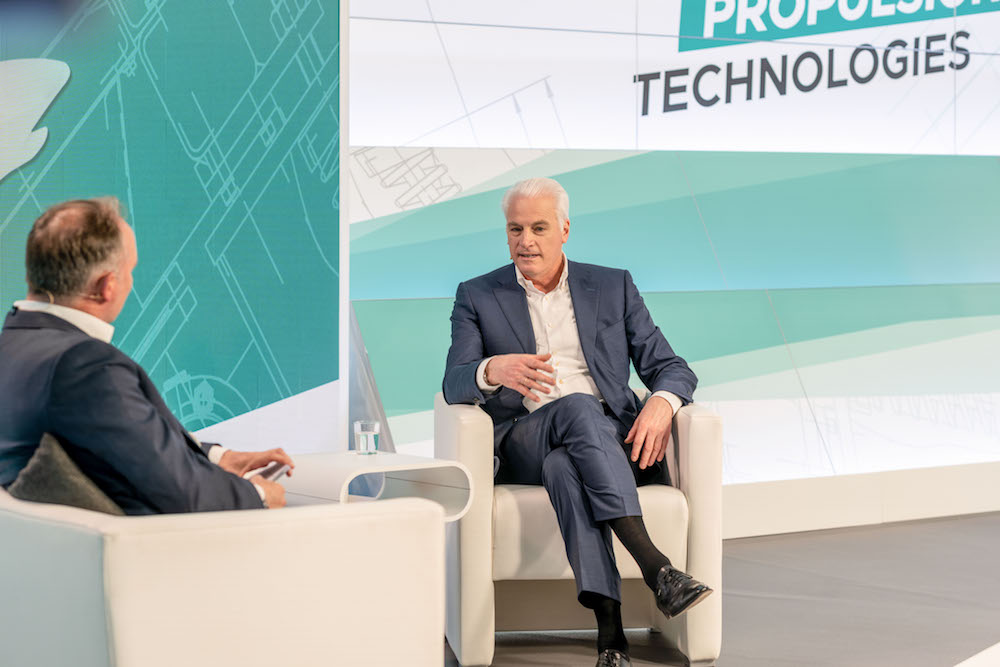
Lürssen is building its first superyacht with fuel cell technology for a pioneering and technology-driven client. The fuel cell will be flanking conventional generators and represents a major step towards an emissions-free superyacht. The new technology should make it possible to anchor emission-free for 15 days or cruise 1000 miles at a slow speed.
“My grandfather built the world’s first motorboat in 1886, my dream is to be the first to build a yacht without a combustion engine,” states Peter Lürssen, CEO of Lürssen.
To bring the project to fruition, Lürssen is setting up an Innovation Laboratory to simulate and test the integration and operation of a Marine Hybrid Fuel Cell System onboard a yacht powered by methanol. Since 2005 Lürssen has been involved in research projects aimed at using fuel cells on ships to advance sustainable shipbuilding.
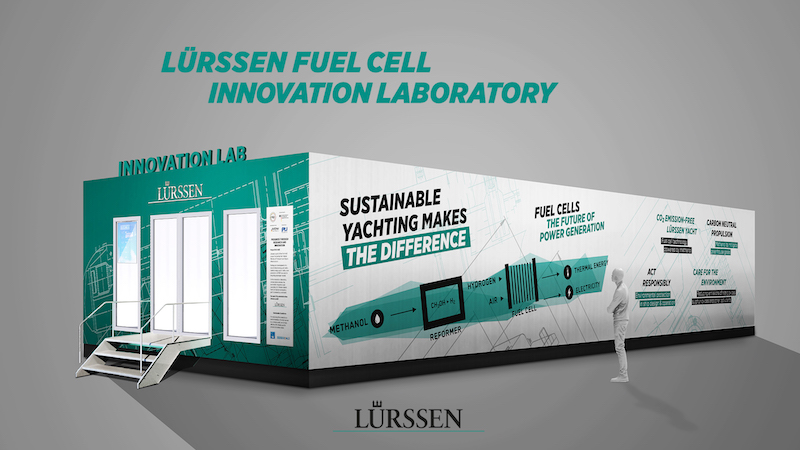
“We don’t just want to use the latest technology on our yachts – we want to advance the status quo. And, in order to change things, we have to be active. That is why we have teamed up with several top partners,” continues Lürssen.
Since 2009, Lürssen has been a partner of a national research project called ‘Pa-X-ell’ with Besecke, Carnival Maritime, DLR, DNV, EPEA, Freudenberg and Meyer Werft. The aim of Pa-X-ell is the development and testing of a hybrid energy system with a new generation of PEM fuel cells for yachts and seagoing passenger vessels.
“The Innovation Laboratory will be ready in summer 2021 and under real-life ambient conditions and with all required auxiliary systems we consider this demonstration plant to be the final preparations to bring fuel cells onboard a yacht successfully,” comments Dr Justus Reinke, managing director of Lürssen. “It will definitely bring us a step closer to a C02 emission-free Lürssen yacht.”
Lürssen has committed to a strategic partnership with Freudenberg, one of the leading experts for maritime fuel cells and a global technology group. “With Freudenberg we have a strong partner at our side. We both have the aim to bring fuel cells onboard ships in the near future and revolutionise the yacht’s energy and propulsion system,” explains Lürssen.
“We are pleased to enter into a long-term partnership with Lürssen, the leading, innovative shipyard in the yacht sector. Together we will set standards for sustainable, emission-free mobility for yachts,” adds Claus Moehlenkamp, CEO of Freudenberg Sealing Technologies.
Lürssen’s and Freudenberg’s concept is a fuel cell driven by hydrogen which is continuously reformed from methanol. The choice of methanol rather than elemental hydrogen has been made due to its higher energy density, the simplicity of handling and worldwide availability. Perhaps most importantly, however, methanol can be stored in structural tanks in the double bottom of a yacht in contrast to pressurized or liquefied hydrogen which requires valuable space above the tank top and extensive tank structures.
“Based on our vast knowledge in Fuel Cell Systems and Hydrogen generation by reforming methanol in connection with Freudenberg’s proven industrialization expertise, we are committed to realising innovative power and propulsion solutions for the maritime industry,” explains Dr Manfred Stefener, head of the lead center fuel cell systems of Freudenberg Sealing Technologies. “We are happy to have Lürssen as partner for bringing the combination of the mature polymer electrolyte fuel cells (PEMFC) with an efficient conversion process of methanol into hydrogen on the first yacht worldwide.”
According to Lürssen, methanol is an important base material for the chemical industry and has been an option to be used as a clean fuel for decades. When produced from renewable sources like by CO2 capture from the atmosphere methanol can be completely climate-neutral.
“Due to the low dynamic capability of fuel cells the system layout and the combination with other energy converters and storages is the key for a successful fuel cell power system. The yacht, which is currently under construction, will be able to stay more than 15 days at anchor with the night time power supply being a zero-emission mode. And the yacht can reach more than 1000 miles slow cruising with zero-emission,” comments Lürssen.
According to Lürssen, the modular construction of the methanol fuel cell system can be adjusted to a customized yacht to keep space requirements and costs as low as possible and the efficiency of the system as high as possible. Fuel cells cause almost no noise or vibrations, need only minor maintenance and are more efficient than diesel engines. However, most importantly, emissions like nitrogen oxides, sulphur oxides, soot and CO2 can be avoided when green methanol is used.
Profile links
Join the discussion
To post comments please Sign in or Register
When commenting please follow our house rules
Click here to become part of The Superyacht Group community, and join us in our mission to make this industry accessible to all, and prosperous for the long-term. We are offering access to the superyacht industry’s most comprehensive and longstanding archive of business-critical information, as well as a comprehensive, real-time superyacht fleet database, for just £10 per month, because we are One Industry with One Mission. Sign up here .
Related news
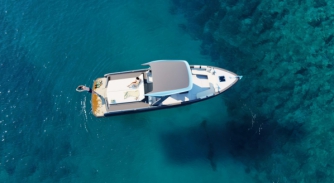
La Ciotat Shipyards welcomes hydrogen pioneer HYNOVA to its yachting village
The hydrogen propulsion company HYNOVA has been offered the business unit lot 14 in LCS' Yachting Village

Oceanco introduces the new KAIROS concept
The new project has been designed in line with Oceanco's NXT initiative on sustainability an innovation

30.78m La Dolce Vita sinks in marine sanctuary
After a fire broke out on the starboard generator, the vessel subsequently sank and spilt diesel into a protected area
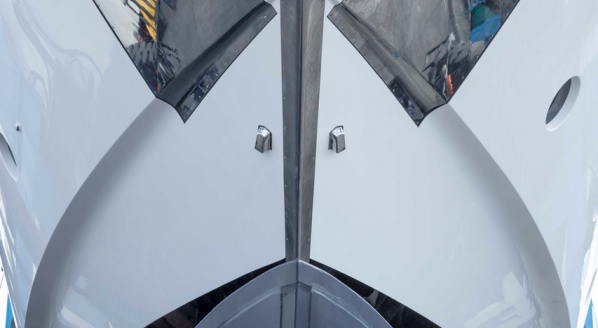
Azimut Benetti reports on the 'Paint-it Project'
The project is designed to develop a new environmentally friendly manufacturing approach for marine antifouling
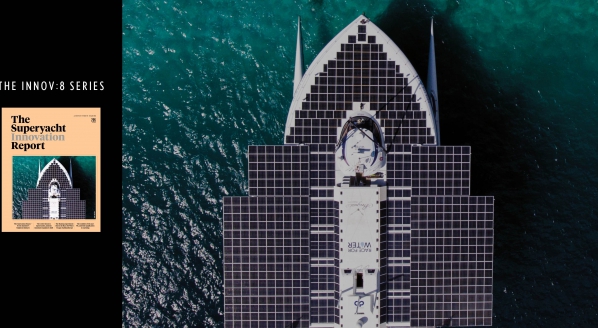
Innovation and running the Red Queen's race
We introduce the Innov:8 series of video interviews
3 years ago
4 years ago
Sign up to the SuperyachtNews Bulletin
Receive unrivalled market intelligence, weekly headlines and the most relevant and insightful journalism directly to your inbox.
Sign up to the SuperyachtNews Bulletin
The superyachtnews app.

Follow us on
Media Pack Request
Please select exactly what you would like to receive from us by ticking the boxes below:
SuperyachtNews.com
Register to comment
Yachting Monthly
- Digital edition

Hydrogen powered boats: what are the realistic options?
- Sam Fortescue
- November 24, 2021
Hydrogen is the future of energy – everyone says so. Billions of pounds of funding have been unveiled as part of the Government’s UK Hydrogen Strategy, which includes marine sector targets

Hydrogen fuel has the potential to be entirely carbon-free, producing just water as a by-product of its use. Credit: Scharfsinn/Alamy
Hydrogen is the future of energy – everyone says so. But what options are there for hydrogen powered boats?
The yacht industry may still be gingerly getting to grips with battery-powered craft and electric yachts , and us leisure sailors are still wedded to our dirty diesels , but the hydrogen revolution is coming to boating.
In fact it may be here already, according to Tom Sperrey of Fuel Cell Systems in Berkshire.
‘We could do it today,’ he tells me. ‘I could have your boat in the water with a fuel cell by the spring for £100k plus the cost of the boat!’
Hydrogen fuel has the potential to be entirely carbon-free, producing just water as a by-product of its use.
A decade or more ago, it was assumed that hydrogen combustion would provide a useful stepping-stone to the use of hydrogen fuel cells, because it allowed manufacturers to use existing engine blocks and design.

Hydrogen modules are among the smallest that exist and require a plastic-lined cylinder for storage under pressure
But burning hydrogen in a thermal engine is up to 50% less efficient than reacting it with air in a fuel cell, and pretty noisy to boot, so this approach has been sidelined in favour of adopting more innovative solutions.
In cars or boats, where every mile of extra range is critical, a key challenge with fuel cells is how to store the hydrogen.
It is a gas at normal pressure and temperature, which means that it has to be heavily compressed to get enough of it into a tank.
At sea, the current limit is 350bar, although the automotive industry has approval for 700-bar storage, which gives an extra 25% capacity.
But, to maintain such pressure, you need specialist carbon cylinders lined with impervious plastic, as well as a system of robust pumps and piping.
And that adds both cost and weight.

‘In the near future, there’ll be hundreds of 32 foot hydrogen powered boats,’ promises Daedalus founder, Michael Reardon
Using a 350-bar system, the weight of the fuel cell and the hydrogen storage system still comes in below that of a traditional diesel set-up, but it requires more volume and it costs more.
Using gaseous hydrogen as a fuel leads French marine fuel cell developer EODev to be cautious about marine applications.
‘We’re not looking at replacing the diesel engine – although that is the ultimate goal. [Our target] is limited cruising in inshore areas. It makes perfect sense from an environmental perspective.’
Hydrogen powered boats: Liquid fuel
Another approach is to use a liquid fuel that is rich in hydrogen – like methanol or ammonia.
They naturally contain less usable energy than pure hydrogen, so are less efficient, but being stored in standard fuel tanks makes them easier to integrate with current designs of boat.
The drawback here is that methanol reactions generate CO2 and ammonia produces polluting nitrous oxides.
All these fuels can be produced industrially from fossil fuels, with the associated emissions, or from water and air using renewable energy .
Continues below…

Electric yacht: What are the options for going electric?
Electric and hybrid yachts are growing in popularity; we outline the current options for those making the switch

Renewable energy afloat: the latest tech
Sam Fortescue examines how renewable energy afloat is benefitting from technical developments in other sectors

How lithium batteries are changing onboard power
Duncan Kent investigates the technology used in lithium batteries and explains what to consider in matching them with a management…

Would you switch to electric propulsion?
Would you make the switch? We ask two sailors who have looked at how the real-world numbers stack up on…
This gives rise to different ‘colours’ of fuel, ranging from green to grey, brown and black – a loose measure of how environmentally friendly they are.
The other challenge is a relative lack of infrastructure for distributing pure hydrogen (of any colour), which makes it rather difficult to fill up during a cruise.
‘Right now, the thing that’s stopping us is the availability of hydrogen,’ agrees Sperrey.
His company has developed a stand-alone refueller called the HyQube as well as refuelling stations on wheels.
Growing momentum for hydrogen powered boats
Across Europe , many pilot schemes are being rolled out via mobile or small-scale distributors and there are already 11 UK filling stations – concentrated in the south-east of England.
It would not take a big leap to start developing a distribution network around petrol station forecourts and extending to key harbours .
More excitingly, the French company EODev is building a floating hydrogen refuelling station which actually makes its own hydrogen by desalinating and electrolysing seawater in the harbour.

Phil Sharp is on a mission to race around the globe in the world’s first hydrogen race yacht
With all these ifs and buts, you might think that the technology would not be ready yet for actual boaters.
But there are already several marine-specific power modules on the market, ranging from 40W to 200kW.
Naturally enough, big engineering firms like ABB and CMB are also building much larger fuel cell systems for commercial vessels, and this will have a trickle down effect in time.
If you want to go emissions-free now, it’ll cost €100k upwards, so it’s an expensive project.

Hydrogen powered boats: At 6 knots, the new Hynova 40 motorboat has a range of 69 miles courtesy of 22.5kg of hydrogen stored in three cylinders
That would make much more sense as part of a luxurious new build project, like the D88 catamaran from Daedalus, which will make its own hydrogen as it goes.
But Daedalus founder Michael Reardon is convinced the technology will trickle down quickly.
‘In the very near future, there’ll be hundreds of hydrogen 32-footers,’ he promises.
In the meantime, you can always use an Efoy methanol cell so you don’t have to fire up the engine for battery charging.
Efoy fuel cells have long been a staple of boat show stands and are now on their fifth generation, leading the market for small-scale methanol units.
The marinised models are the Efoy 80 and Efoy 150 – slightly confusingly generating 40W and 75W of power respectively, at 12V or 24V.
You can simply connect them up to standard, gel, AGM or lithium batteries, although they are at their most efficient paired with an Efoy lithium cell.
‘I have an Efoy on my boat which is 12 years old,’ says Sperrey. ‘It’s been very reliable. As with all fuel cells its performance declines over time.’

EFOY fuel cells lead the market for small-scale methanol units
Both units are fairly compact (448 x 198 x 275mm) and weigh less than 7kg, making them easy to site.
No need to worry about exhaust gases – just a small quantity of waste water, which should be drained or collected.
You can install an optional control panel in the system to see what’s going on, or add an Efoy Bluetooth adapter – sometimes bundled – and consult the Efoy app via smartphone or tablet.
Liquid methanol fuel comes in 5L or 10L canisters costing £75.60 or £106.80 respectively.
You can also order a 28L canister. At 12V, expect to get 460Ah (5.5kWh) out of the small 5L cartridge or 925Ah (11.1kWh) from the big 10L one.
Efoy 80 BT: £2,670 Efoy 150 BT: £4,230, www.fuelcellsystems.co.uk
Genevos HPM-15
Spun out of the sailing campaign of Phil Sharp and his IMOCA 60 OceansLab , this is a hydrogen-based power module that you can order now, although manufacturing is still at a low level, so you won’t receive your fuel cell module until 2022.
It is in a different league to the Efoy, capable of generating up to 15kW of continuous power.
This makes it suitable for propulsion in smaller or easily driven boats, and should easily cover hotel loads on a larger boat with lots of gadgets.
One of the benefits of proton membrane exchange technology like this is that it can supply even very low currents efficiently and step up in the blink of an eye.
The extra power comes with extra dimensions, though.

A hydrogen-based power module that you can order now, although you won’t receive it til 2022
The unit is over a metre long (110cm), 65cm wide and 35cm high, although it weighs in at just 90kg.
Genevos is also developing larger units with outputs of 30kW and 45kW.
The cost of buying and installing a full system starts at around €100,000, according to Sharp.
‘The price of fuel cells and green hydrogen is really going to drop, especially when large scale electrolysis gets online,’ he says.
‘We’re expecting a 70% reduction in costs. By 2025, there’ll be production boats with hydrogen energy systems.’
HPM-15: c£42,750 (€50,000) www.genevos.com
EODev REXH2
As the name here implies, this unit is considered as a range extender to an electric boat , but it is also an effective generator.
It has been developed by the commercial spin-off of the Energy Observer project, which is in the process of sending a specially designed hydrogen-electric craft around the globe without a drop of fossil fuel.
The other partner was car-maker Toyota, which provided the fuel cell technology – identical to that in its new Mirai car.

REXH2 is a hydrogen range-extender to an electric vessel, and a generator
The headline power rating is 70kW – roughly equivalent to 94hp, and the unit is ‘stackable’ so you can install several in series for more power.
Like all hydrogen fuel cells, it is silent, can instantly generate power across its full range of outputs and produces only water as a waste product.
Although it is a recent product, the first commercial demonstration is already afloat; the new Hynova 40 motorboat – currently on a publicity tour in the south of France .
Its top speed is 22 knots and, at 6 knots, it has a range of 69 miles courtesy of 22.5kg of hydrogen stored in three cylinders.
EODev is looking at smaller units too, and admits that the current cost of the REXH2 makes it unlikely to appeal to smaller boats.
‘Our objective is to bring [the price] down significantly within the next couple of years once full industrialisation is underway,’ says Tallieu.
€180,000, www.eo-dev.com

Find anything, super fast.
- Destinations
- Documentaries

Feadship Announces Build of Hydrogen Fuel Cell Powered Superyacht
By Emily Dawkins
Feadship has unveiled that construction on its first fully certified liquid hydrogen fuel-cell superyacht has now begun. Feadship Director and Royal Van Lent Shipyard CEO, Jan-Bart Verkuyl, announced the news on the yard's social media channels over the weekend.
Renowned for its dedication to sustainable shipbuilding, green company practices and eco-conscious industry commitments, Feadship has now gone one step further in the move to developing solutions for a more sustainable industry, unveiling that its first fuel-cell powered superyacht is now under construction.
The in-build, hydrogen-powered vessel will be fitted with a cryogenic fuel tank which will store liquified hydrogen at roughly -250°C: the densest method of storage of pure hydrogen. This sufficient store will enable cruising at moderate speeds as well as powering the onboard hotel load during summer conditions.
Within its social media reveal, the shipyard emphasised the excellent nature and increased interest in hydrogen as a fuel source, namely through its efficient production through electrolysis from electricity. The yard commented on how by increasing the use of solar, wind and other renewable energies, green hydrogen production will escalate to buffer those renewable power sources.
This news comes as no real surprise however, as at the end of 2022, the Dutch shipyard revealed that it had achieved a major milestone in the journey to carbon neutrality by receiving approval-in-principle from Lloyd’s Registry for an ‘agnostic’ fuel system.
As a major progression and second step in its ‘Feadship Pure: Aiming for Zero %’ roadmap, which showcases the yard’s plan to go from diesel hybrid to methanol in less than a decade, the Lloyd’s approval kickstarted this vital step forward for the design teams at Feadship, and therefore strengthened the third step in its roadmap to building a fuel-cell powered yacht by 2030.
Whilst details of this significant news remain sparse, readers can expect to hear more from the yard about the yacht’s build in the coming months.
"Besides meeting the growing desire of our clients for carbon neutrality, it will help to minimise the environmental impact of our yachts wherever they may cruise in the world" Giedo Loeff, Head of R&D, Feadship
"Besides meeting the growing desire of our clients for carbon neutrality, it will help to minimise the environmental impact of our yachts wherever they may cruise in the world"
More news About…
Companies linked to this story, more news from ..., industry news.
Hydrogen cars flopped, but fuel cells are finding new life in trucks and boats
Mining trucks, cement mixers, and terminal tractors all seem like the perfect use of hydrogen fuel cells. but they run into the same challenges around price and fueling..
By Andrew J. Hawkins , transportation editor with 10+ years of experience who covers EVs, public transportation, and aviation. His work has appeared in The New York Daily News and City & State.
Share this story
:format(webp)/cdn.vox-cdn.com/uploads/chorus_asset/file/25580932/1240388737.jpg)
Twenty years ago, it seemed like hydrogen fuel cell vehicles would have a bright future.
The cars were cool — luxury sedans with sleek interiors and futuristic-looking touchscreens. They were environmentally friendly, with water vapor as their only byproduct. Regulators were on board, promising big investments for the fueling infrastructure. A bet on the most abundant element in the universe in the fight against air pollution, and eventually climate change, seemed like a sure thing.
But despite tens of thousands of vehicles sold and billions of dollars spent on fueling, that bet has yet to pay off. California remains the only state in the country with any sort of hydrogen fueling infrastructure, with fewer than 50 stations currently in operation. Vehicle sales have essentially collapsed: only 322 fuel cell vehicles were sold in the first half of 2024, 82 percent lower than a year ago.
The fueling infrastructure also seems on the brink of collapse. Stations are shutting down, and the ones that are still in operation are routinely offline due to tech problems and fuel shortages. The price of hydrogen continues to climb, as production problems and supply shortages roil the market.
Tesla CEO Elon Musk called hydrogen fuel cell vehicles “mind-bogglingly stupid”
Critics have panned hydrogen as an inefficient and illogical way to decarbonize transportation. After all, battery-electric vehicles already exist. Tesla CEO Elon Musk called hydrogen fuel cell vehicles “mind-bogglingly stupid.”
But hydrogen still has the potential to be a game changer in the fight against climate change, if we can find a better solution. Despite their early failures, major companies are still pouring billions of dollars into the technology. Governments are drawing up infrastructure plans and passing tax credits in the hopes that they can provide a helping hand.
If hydrogen fuel cells are to hang on, it’s time to think bigger.
The boat bobbing in the waters near Wall Street doesn’t look like the other vessels that typically populate New York’s congested waterways. For one, it isn’t belching diesel smoke like all the shipping containers, oil tankers, and garbage barges. Actually, it isn’t emitting any pollution at all.
The ship, named the Energy Observer, is a sleek, 100-foot-long former French racing catamaran retrofitted with solar panels, slowing sipping sunlight to send to the four lithium-ion batteries sitting below deck. The panels cover almost the entire surface of the boat, so you either have to wear special cloth booties to come on board — or just go barefoot.
On an overcast day last April, it had just completed a seven-year voyage around the world, visiting numerous countries to preach the gospel of renewable energy. Energy Observer is basically a floating laboratory, where its six-person crew can conduct experiments on sustainable energy in order to prove how it can be used to power all types of vessels.
:format(webp)/cdn.vox-cdn.com/uploads/chorus_asset/file/25575383/2079427261.jpg)
The boat produces all the energy it needs to sail, and it does that through three different methods. The first is solar, through the aforementioned panels. The second is wind power, which is generated through these massive twin masts that look like two airfoils standing straight up. The crew calls these “Ocean Wings,” and they make about 30 percent of the boat’s propulsion power and can move the boat up to 12 knots without impacting its electricity consumption.
The third is hydrogen, which works like this: Seawater is filtered through the hulls to be desalinated and purified before an electrolyzer splits H20 into hydrogen and oxygen. The hydrogen is then converted into electricity courtesy of a Toyota fuel cell, a similar version of the technology that is used in the automaker’s hydrogen-powered sedans, which emit water vapor instead of carbon pollution.
The hydrogen is then converted into electricity courtesy of a Toyota fuel cell
“That’s really the purpose of the ship,” said George Conty, the ship’s affably Swiss boatswain, “producing hydrogen from a mix of renewable energies.”
The Energy Observer isn’t very fast, maxing out at around 11 knots, which is much slower than a typical catamaran. Its racing days are long gone, which makes sense because speed isn’t the ship’s ultimate mission. It’s a demonstration project to prove that hydrogen from renewable sources can be a viable alternative to diesel and other polluting fuels used in maritime.
Shipping accounts for about 3 percent of greenhouse gasses, similar to flying. Transportation on the whole represents over a quarter of all planet-warming emissions. Decarbonizing the sector will be a monumental challenge, and lithium-ion batteries can’t do it alone.
Energy Observer’s team isn’t just banking on a 100-foot-long catamaran to prove its point. A successor, a massive cargo ship called the Energy Observer 2, is still just in the planning phases. And if the companies backing the project can raise enough money to fund its creation — and that’s a big if — it has the potential to demonstrate that liquid hydrogen deserves to be discussed alongside other less carbon-intensive alternatives like biofuels, ammonia, and natural gas.
The Energy Observer 2 will be able to transport 1,100 20-foot-long shipping containers over a distance of 1,800 nautical miles
Once built, the Energy Observer 2 will be able to transport 1,100 20-foot-long shipping containers over a distance of 1,800 nautical miles — not enough for a trans-Atlantic crossing, but enough for intercontinental trips. Like its predecessor, the cargo ship will also run on hydrogen fuel cells provided by car companies like Toyota — just a lot more of them. Over 100 fuel cells, using over 40 tons of liquid hydrogen, generating approximately 4.8 megawatts of power.
“No project in the world has this power,” Victorien Erussard, the ship’s captain, told me. But his venture is already running into familiar problems around cost and refueling infrastructure. It’s not going to be an easy transition. It will require more investors, more supporters, and more true believers in hydrogen to make this work.
“Many, many, many more boats,” Erussard said.
:format(webp)/cdn.vox-cdn.com/uploads/chorus_asset/file/25575337/451081216.jpg)
Truck stuff
But also trucks — which General Motors knows a thing or two about. Especially the leviathan-sized ones that are big enough to handle the heaviest loads.
GM was one of the first automakers to stick a hydrogen fuel cell into a vehicle. The company’s 1966 Electrovan, a converted GMC Handi-Bus with hydrogen-oxygen power, could reportedly do 70mph and travel 150 miles.
Today, the company’s fuel cell-powered vehicles look a little different. GM’s Hydrotec division is investing in heavy-duty trucks — think mining equipment, cement mixers, and terminal tractors — as well as a few medium-duty ones. The idea is to use hydrogen to decarbonize heavy industries, which is ill-suited for battery-electric vehicles that are slow to charge.
Even hydrogen’s profound fueling shortcomings could be easily fixed. Heavy-duty trucks typically operate in confined spaces, like construction sites, warehouses, ports, and quarries. Under those circumstances, fueling stations can be centrally located to service a whole fleet of hydrogen fuel cell vehicles. No need for a hydrogen fueling station on every residential street corner.
GM was one of the first automakers to stick a hydrogen fuel cell into a vehicle
It’s still “early days,” Hydrotec’s executive director, Charlie Freese, tells me. GM is still testing its technology to see what works and what won’t. In addition to the trucks, there’s also the fuel cells themselves, bundled together into a cube-shaped package, befittingly called Power Cubes. These cubes, developed alongside Honda, can be used to power several different vehicles. They can even be used for stationary power generators for outdoor events, replacing all those dirty diesel generators used today.
Other automakers, like Toyota, rushed too quickly into the passenger vehicle market before the fueling infrastructure was in place, Freese said. The Toyota Mirai, the first mainstream fuel cell vehicle that was first introduced in 2014, may have been a ground-breaking vehicle at the time, but now it’s an albatross for many of the owners.
“It was clear that that wouldn’t be a very rewarding experience,” Freese said. “The technology really lends itself best to the heaviest vehicles, the ones that carry heavy payloads, travel the longest distances, and need very fast refueling.”
GM has not released a fuel cell vehicle for the consumer market, but its joint venture with Honda just started mass-producing fuel cells at its Michigan plant earlier this year. And a medium-duty truck, based on the Chevy Silverado 5500, is on the way. GM thinks it could be the ideal work truck for farmers.
“It’s not going to be perfect right at the immediate outset,” Freese admitted. Most hydrogen in the US is what’s called “gray hydrogen,” meaning it is produced through a process called steam methane reforming, which emits greenhouse gases. The hope is to eventually switch to “green hydrogen,” made by renewable energy sources like solar and wind. But we’re not there yet.
“If I’m using a hydrogen fuel cell, I’m greening my fleet, even if it’s gray hydrogen,” Freese said. “And over time, the gray hydrogen can be replaced with green hydrogen. But that takes more of a build-out of the infrastructure… they got to grow together.”
:format(webp)/cdn.vox-cdn.com/uploads/chorus_asset/file/25579610/2166211608.jpg)
Fueling failures
Jacob Brouwer was one of those early adopters of hydrogen. He drove a Toyota Mirai for over seven years, attracted to its smooth acceleration, boastful range, and luxury interior. The $15,000 prepaid fueling card from Toyota didn’t hurt, either.
But these days, he drives a Tesla. It doesn’t reflect well on hydrogen when the director of UC Irvine’s Clean Energy Institute has decided that a car made by Elon Musk is preferable to one that runs on fuel cells. He blames California’s energy regulators for fumbling the rollout, failing to get to the promised 200 stations and leaving the project incomplete.
“We just didn’t fulfill the plan,” Brouwer says. “I feel very bad for the Mirai owners.”
“I feel very bad for the Mirai owners.”
But despite his firsthand experience with the shortcomings, he’s less pessimistic than most when it comes to the future of hydrogen. In addition to boats and heavy trucks, he sees numerous applications as being perfect for fuel cell technology, including tractors, buses, freight, trains, light-duty hybrid vehicles, and even aviation.
Indeed, there have been some compelling experiments in fuel cell-powered flight. Joby Aviation is developing a hydrogen-powered version of its vertical takeoff and landing aircraft for longer trips between cities. And American Airlines recently agreed to buy 100 hydrogen-electric engines from ZeroAvia, a fuel cell aviation startup, to power its regional jets.
Aviation is especially difficult to decarbonize; aircraft need to be just light enough to achieve flight, and heavy lithium-ion batteries would screw up that ratio. Hydrogen is practically feathery in comparison.
There are uses for hydrogen even beyond transportation, Brouwer said. Cement and steel comprise about 12 percent of greenhouse gas emissions. Hydrogen is better suited to decarbonize cement and steel production than batteries. Data centers housing servers powering the AI boom — you could run those with hydrogen, too. The list goes on.
But for an element as abundant as hydrogen, it can be maddeningly hard to find.
“Electricity is available everywhere, but hydrogen isn’t”
For all of these applications to become a reality, to become more than just glorified experiments like the Energy Observer or GM’s Power Cubes, they need the fueling infrastructure to rise up, too. Battery-electric vehicles never quite had it this bad. Sure, the public charging experience for EVs leaves a lot to be desired. But electricity has a big head start.
“Electricity goes to every business,” Brouwer said. “Electricity is available everywhere, but hydrogen isn’t.”
He thinks it can get there. The Biden administration is all in on hydrogen, approving tax credits to support the production of green hydrogen and doling out $7 billion for regional production hubs across the US. Things still look grim for the average Toyota Mirai owner, but the clouds seem to be clearing for everything that’s not a light-duty vehicle.
“We are at the beginning of the beginning,” Brouwer said. It’s a strange way to think about a technology that is decades, if not centuries, old. But it’s finally looking as if hydrogen is ready to pull its own weight.
Apple iPhone 16 Pro review: small camera update, big difference
Nintendo and pokémon are suing palworld maker pocketpair, apple iphone 16 and 16 plus review: all caught up, here’s how green bubbles are getting upgraded in ios, former moviepass ceo admits the $9.95 ‘unlimited’ ticket scheme was fraud.

More from Transpo
:format(webp)/cdn.vox-cdn.com/uploads/chorus_asset/file/25603299/332052_New_Volvo_EX90_on_the_road.jpg)
Volvo is giving itself another decade before it commits to selling only EVs
:format(webp)/cdn.vox-cdn.com/uploads/chorus_asset/file/25602464/Large_63277_2025IONIQ5Limited.jpg)
Hyundai’s first EV with native Tesla Supercharging is the new Ioniq 5
:format(webp)/cdn.vox-cdn.com/uploads/chorus_asset/file/25601982/Large_17987_VolkswagenbringsChatGPTtoitsvehiclesviavoiceassist.jpg)
New VWs will answer some of your questions with ChatGPT
:format(webp)/cdn.vox-cdn.com/uploads/chorus_asset/file/10752835/acastro_180430_1777_tesla_0001.jpg)
Tesla will need some Hollywood magic for its robotaxi reveal

- Green Propulsion
- Renewable Energy
- Energy efficiency
- Sustainable materials
- Eco Insights
- News & Events
- Sunreef News Magazine
- Press About Sunreef

- 60 Sunreef Power
- 70 Sunreef Power
- 80 Sunreef Power
- 100 Sunreef Power
- Sunreef Ultima Range
- Sunreef 44 Ultima
- Sunreef 55 Ultima
- Sunreef 66 Ultima
- Sunreef 77 Ultima
- Sunreef 88 Ultima
- Sunreef fleet

- Sunreef Zero Cat
- Sunreef 100
- Sunreef Fleet

- Sunreef 35M
- Sunreef 43M
- 49M Sunreef Power
- 210 Sunreef Power Trimaran
- Sunreef Explorer
- 40M Sunreef Explorer
- 40M Sunreef Explorer Eco
- 50M Sunreef Explorer
- Superyachts Fleet
Hydrogen Yachts: An Innovation Powered by The Cleanest Fuel for Zero-Emission Voyages

The consumption of renewable sources of energy remains at the forefront of sustainable yachting as it offers a viable solution for reducing the overall carbon footprint. Recently, hydrogen yachts have emerged as a clean, green, and efficient medium for pursuing seafaring adventures.
Here is everything to know about hydrogen yachts:
The Pioneers of Hydrogen
Around the same time in the 18 th century, British scientist Henry Cavendish and French chemist Antoine Lavoisier first identified the unique element, i.e., hydrogen. Taking a few steps further, in 1839, a Welsh scientist named Sir William Grove discovered the first fuel cell which could combine hydrogen and oxygen to generate electricity with water as the only byproduct – this came to be known as Grove’s Gas Battery.
Hydrogen has also been in use since the 1950s by the National Aeronautics and Space Administration (NASA) for space exploration . The ability of hydrogen to power fuel cells without generating air pollutants (that create smog) has remained the main driver of interest in hydrogen as a fuel alternative over the years.
With the launch of the world’s first hydrogen yacht in 2018, sustainable yachting enthusiasts showcased great interest in the concept. This was largely due to hydrogen yachts significant advantages over traditional yachts, i.e., more cost-effective operations and greater environmental friendliness. In all practicality, a fuel cell proved to be two to three times more efficient in comparison to a gasoline powered internal combustion engine .
The Benefits of Hydrogen
1. economically viable.
One of the most obvious benefits of opting for a hydrogen yacht is that hydrogen fuel is far cheaper than petrol or diesel because hydrogen is the most abundant element in the world. It is said to continue at this rate in the future as production increases with technological advancements .
It is also noteworthy that a hydrogen yacht is more affordable than a traditional yacht, making it ideal for eco-conscious yachters who hope to make the most of long-distance voyages without breaking the bank.
2. Environmentally Friendly
Best believe hydrogen yacht sailors are also spared of pollution taxation and related fees since hydrogen fuel cells emit little to no greenhouse gases with their limited usage of gasoline.
Hydrogen yachts being quieter are an added benefit for peaceful cruising without disturbing the wildlife; this is mainly a result of possessing fewer moving parts. Moreover, hydrogen yachts offer greater convenience as they can be operated for longer durations of time without the need for stopping to refuel or recharge.
3. Advanced Power Generation Compatibility
Contrary to belief, hydrogen yachts do not compromise speed and efficiency. Another crucial benefit of utilizing hydrogen is that it perfectly complements all other renewable sources of energy , be it wind power or solar energy. Further, hydrogen can be produced from water using renewable energy sources when production is high but may also be stored to generate electricity when demand is high, and resources are limited.
But How Do Fuel Cells Work?
Hydrogen yachts are powered by electrochemical cells, also known as fuel cells, which utilize the chemical energy trapped in fuels to produce electricity. In case of hydrogen, the conversion occurs as an effect of the combining of hydrogen with oxygen atoms which produces electricity, water, and heat.
The proton exchange membrane fuel cell (PEMFC) is known to be well-suited for powering hydrogen yachts as they are lightweight and require little maintenance. In terms of operations, fuel cells function similarly to batteries except they produce energy instead of storing energy. A typical fuel cell stack can provide electricity continuously for as long as the fuel is supplied.
Another crucial component of a hydrogen yacht is an electrolyzer that uses nuclear or renewable electricity to split hydrogen and water. The electrolyzer may be powered by a diesel generator or solar panels allowing it to stay operation even when the yacht is not in use.
The Preferred Course of Action
Each fuel cell consists of two electrodes (the positive cathode and the negative anode) sandwiched around an electrolyte. Oxygen is fed to the cathode, whereas the hydrogen to the anode. A catalyst at the anode separates the hydrogen molecules into protons and electrons, enabling each to take a different path towards the cathode.
For starters, the electrons migrate through the external circuit, encouraging a flow of electricity. On the other hand, protons make their way to the cathode via the electrolyte, where they reunite with oxygen and electrons to produce water and heat.
Key Considerations for Installation
Hydrogen fuel cells have immense potential for efficiently storing energy for later production of electricity. However, it is vital to ensure the correct installation for all components onboard.
- Firstly, the fuel cell stack needs to be sized properly to ensure it can power the hydrogen yacht. Aside this, it must be properly sealed and insulated to stop the stack from overheating.
- Secondly, the electrolyzer must be placed in a similar environmental condition with ample supply of hydrogen and oxygen.
- Lastly, the hydrogen yacht must boast an adequate ventilation and exhaust system because hydrogen is a highly flammable; hence, the system must be cooled properly, and exhaust gases must be vented safely.
The fuel cells, electrolyzers, as well as ventilation and exhaust systems must be kept in top-notch condition. Failure to do so may result in decreased performance, increased emissions, and safety hazards. Regular inspection and servicing can help ensure all elements of the hydrogen yacht operate at peak efficiency, remain sustainable, and reduce the cost of ownership overtime.
Combining Hydrogen and Yachts
Hydrogen fuel cells are clean burning energy sources with a relatively high power-to-weight ratio, making them ideal for use in yachts where weight is a critical factor.
Increase in the usage of hydrogen and hydrogen-based fuels can prevent nearly 60 gigatonnes of CO2 emissions by the middle of the 21 st century, directly addressing critical climate challenges. Moreover, in contrast to combustion engines, fuel cells operate at 60 percent higher efficiencies , enabling the conversion of chemical energy in the fuel to electrical efficiency directly.
Hydrogen Yachts by Sunreef Yachts Eco
The first of its kind, the Sunreef 80 Eco Hydrogen yacht is currently under development at the Gdansk shipyard . Hydrogen, as a fuel, will be stored in carbon tanks in their gaseous state onboard the luxury yacht.
All in all, the hydrogen yacht will feature a high-tech fuel cell worth 75kW, a hydrogeneration system, a custom battery bank of 440kWh, inhouse engineered solar system of 32kWp, and two 120kW electric motors. The electricity produced by the hydrogen fuel cell will be used to power the electric motors onboard to ensure minimum environmental impact and maximum energy efficiency.
Frequently Asked Questions
• What yachts are powered by hydrogen?
In response to the growing emphasis on sustainable yachting , Sunreef Yachts Eco is currently developing its first hydrogen-powered sailing catamaran in Gdansk, Poland – this will be called the Sunreef 80 Eco Hydrogen.
• How much is the hydrogen powered yacht?
The Sunreef 80 Eco Hydrogen is priced at roughly about boasting six carbon tanks that contain 55 kilograms of compressed hydrogen (which sums up to 350bar to power the yacht’s engines as well as the appliances onboard. The hydrogen version of the bestselling sailing catamaran will work in harmony with hydrogeneration, electric motors, lithium batteries, and solar power.
• What is the range of a hydrogen boat?
Under favorable conditions, a fuel cell system is well equipped to provide the hydrogen yacht with approximately 500 miles of range using the hydrogen stored onboard alongside the additional power supply from the solar panels to the battery system.
Previous Post Extreme E sustainable racing: RxR Team to compete again with Sunreef Yachts Partnership
Next post palma international boat show.
Comments are closed.
SUBSCRIBE TO OUR NEWSLETTER
- Sailing Yachts
- Power Yachts
- Superyachts
- Making a Change
- Green Concept
- Energy Efficiency
- Sustainable Materials
Copyright © 2024 Sunreef Yachts . All rights reserved.
- Whistleblowing
- Privacy Policy

Sunreef Venture S.A.
Sunreef Yachts Shipyard
ul. Tarcice 6
80-718 Gdańsk, Poland
+48 58 769 77 77
- Ordered by Shipyards & Yacht Brands
- Ordered by Date
- Yacht Designers
- About and Contact
- Yacht Support Vessels
- Tenders & Toys
- Some interesting other sites in the superyacht world
AQUA // Sinot // Fuel Cell Yacht
Aqua is the project name of this 112m fuel cell (hydrogen) superyacht by sinot yacht architecture & design and lateral naval architects..
According to the design studio, AQUA ‘s exterior lines are inspired by ocean swells. The sharp reverse bow reminds me of NAUTILUS – the ship in the movie The League of Extraordinary Gentlemen . SINOT placed the AQUA room here, like in NATURE – one of the studio’s previous projects. This area belongs to the owner’s area. The designers used curvy lines on the bridge deck on top of the yacht and rear lines of the vessel. The bridge deck also features a helipad.
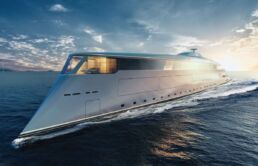
The Hydrogen Propulsion
AQUA has large hydrogen capacity (two 28-ton tanks) for an operating range of 3,750 nautical miles at 17 knots. The proton exchange membrane (PEM) fuel cells generating power of four MW to support the hotel functions and the electric engines (one MW each) with contra-rotating propellers and Voith Schneider propellers. The hydrogen is stored at -253° Celsius.
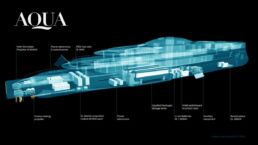
Interior styling of AQUA
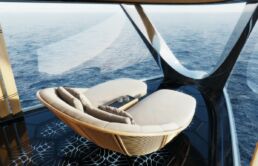
Main Specifications AQUA
Length Overall
NAUTICAL MILES
Has it been sold to Mr. Bill Gates?
Many mainstream news media reported the sale of a hydrogen yacht to the Microsoft founder Mr. Bill Gates and showed renderings and videos of AQUA. The design studio said that it is not valid. There are no relations to Mr. Gates; the concept is still under development and is a showcase project to inspire innovative clients.
SHARING IS CARING - THANK YOU!
7-oceans // dlba naval architects, a88 gransport // officina armare, liva // abeking & rasmussen // joseph dirand architecture, madsummer // lürssen, pura – 40m by royal huisman and mani frers, excellence // abeking & rasmussen // winch design, dislopen // crn yachts // zuccon international project, tecnorib pirelli 1900.
About Publisher

Using a minimum of third party cookies for YouTube, Vimeo and Analytics.
Privacy Preference Center
Privacy preferences.
Google Analytics
672 Wine Club
- Motorcycles
- Car of the Month
- Destinations
- Men’s Fashion
- Watch Collector
- Art & Collectibles
- Vacation Homes
- Celebrity Homes
- New Construction
- Home Design
- Electronics
- Fine Dining
- Benchmark Wines
- Brian Fox Art
- Disneyland Resort
- Ka La’I Wakiki Beach
- Kalamazoo Grill
- Raffles Hotels & Resorts
- Sports & Leisure
- Health & Wellness
- Best of the Best
- The Ultimate Gift Guide
This New Sailing Catamaran Will Be Powered By Yachting’s First Hydrogen Fuel Cell
French builder fountaine pajot will soon introduce zero-emissions, zero-noise hydrogen power to the cruising world via its samana 59., michael verdon, michael verdon's most recent stories.
- This Bonkers Space Balloon Just Completed Its First Full Test Flight
- This New 72-Foot Yacht’s New Hybrid Propulsion System Is the First of Its Kind
- SpaceX’s Polaris Dawn Finally Launches Its Historic Mission
- Share This Article

Fountaine Pajot will be the first shipyard to integrate hydrogen as an alternative energy solution on its catamarans. The French builder said that, as part of its Odyssea 2024 plan, it has chosen EODev’s hydrogen generator, REXH2, to power its Samana 59 sailing multihull. Equipped with the latest-generation Toyota fuel cells, the generator is designed to perform in harsh maritime environments.
Related Stories
- This Roadster Is an Ode to the First Shelby Cobra Prototype—Here’s What It’s Like to Drive
This 246-Foot Electric Superyacht Concept Is Designed to Shine Like a Diamond
- Norway Is the First Country to Have More EVs Than Gas-Powered Cars
“The choice of EODev’s technology is the illustration of our desire to bring together experts in solutions that benefit everyone, and to give substance to our ambition to achieve zero carbon emissions by 2050, whether for the production of boats or their use,” said Romain Motteau, Fountaine Pajot CEO, in a statement.
Aboard the 59-foot Samana, the REXH2 will be capable of supplying up to 70kW and charging a 44kWh LiFePO battery designed for maritime use. The system will consist of a battery, cooling system, distribution board, hydrogen supply line and a tank with a capacity of 7.5 kilograms of hydrogen.

EODev’s compact REXH2 hydrogen generator is built around Toyota’s latest generation of fuel cells. Courtesy EODev
The company said additional tanks could be added to offer extended range.
EODev also developed an automated power management system that calculates the remaining range the same way a car does. The company said that the absence of moving parts in the plug-and-play system will make the fuel cell easy to maintain. Its service life will be at least 15,000 hours. The system was designed to be compact, measuring only about 10 square feet, and fully automated so the boat owner does not need to be an expert, said Motteau.
The hydrogen system’s advantages over conventional gas or diesel engines include zero emissions and no engine noise. Fountaine Pajot said the hydrogen generator will also perform better than an all-electric system. The modular design can also be optimized for each boat. The first Samana 59 with the EODev technology will be launched at the beginning of 2022.

The first Samana 59 with the hydrogen system will be launched early next year. Courtesy Fountaine Pajot
Lürssen announced last week that its first hydrogen-powered superyacht will be launched in 2025. The German builder said that the zero-emissions propulsion system will allow the owner to spend more than 15 nights at anchor or travel more than 1,000 nautical miles without releasing any emissions. The fuel-cell system is much larger and more complex for a superyacht than a smaller boat. Lürssen said it began to develop the system in 2008.
Read More On:
- Sailing Yacht
More Marine

This New Superyacht Line Wants You to Feel Like You’re Cruising in a Sports Car

The Shipyard That Built the ‘Titanic’ Has Filed for Bankruptcy

This New Catamaran Concept Was Designed to Carry Your Bugatti Across the High Seas

Meet the Wine Club That Thinks Differently.
Receive editor-curated reds from boutique California producers four times a year.
Give the Gift of Luxury
Latest Galleries in Marine

The 11 Most Exciting Superyacht Debuts at the Monaco Yacht Show

Tribale 120 Gran Turismo in Photos
More from our brands, the 9 best designer coffee table books for luxury fashion lovers, philly mayor supports 76ers’ $1.3 billion downtown arena plan, ‘agatha all along’ puts the mcu under kathryn hahn’s kooky, captivating spell: tv review, report finds art sales stagnate, even as the luxury sector continues to grow, the best yoga mats for any practice, according to instructors.

The global authority in superyachting
- NEWSLETTERS
- Yachts Home
- The Superyacht Directory
- Yacht Reports
- Brokerage News
- The largest yachts in the world
- The Register
- Yacht Advice
- Yacht Design
- 12m to 24m yachts
- Monaco Yacht Show
- Builder Directory
- Designer Directory
- Interior Design Directory
- Naval Architect Directory
- Yachts for sale home
- Motor yachts
- Sailing yachts
- Explorer yachts
- Classic yachts
- Sale Broker Directory
- Charter Home
- Yachts for Charter
- Charter Destinations
- Charter Broker Directory
- Destinations Home
- Mediterranean
- South Pacific
- Rest of the World
- Boat Life Home
- Owners' Experiences
- Conservation and Philanthropy
- Interiors Suppliers
- Owners' Club
- Captains' Club
- BOAT Showcase
- Boat Presents
- Events Home
- World Superyacht Awards
- Superyacht Design Festival
- Design and Innovation Awards
- Young Designer of the Year Award
- Artistry and Craft Awards
- Explorer Yachts Summit
- Ocean Talks
- The Ocean Awards
- BOAT Connect
- Between the bays
- Golf Invitational
- BOATPro Home
- Superyacht Insight
- Global Order Book
- Premium Content
- Product Features
- Testimonials
- Pricing Plan
- Tenders & Equipment

Sanlorenzo to deliver fuel cell-powered superyacht by 2024
Related articles.
Italian shipyard Sanlorenzo has announced plans to build and deliver the first fuel cell-powered superyacht by 2024.
Massimo Perotti, chief executive of Sanlorenzo , will be the new owner of the 50 metre ground-breaking build and fund the development of the hydrogen technology on board. The fuel cells will generate enough electricity to power the hotel load when the generators are off allowing owners to spend more time at anchor and captains to complete manoeuvres without the need to consume fuel.
To bring the technology to market, Sanlorenzo has entered an exclusive partnership with Siemens Energy and the pair will work together to develop fuel cell solutions in the 24 to 80 metre segment of the market. The “Net-zero GHG emission” system will also be compatible with the limited space available on board.
In a statement, Perotti said the project was of "extreme importance" and an "avant-garde experimentation to introduce a new paradigm in the contemporary yachting."
Elsewhere, German shipyard Lürssen has also signed an order for a superyacht powered by fuel cell power . The yacht has been commissioned by a “pioneering and technology-driven client” and will feature fuel cell technology driven by hydrogen, which is continuously reformed from methanol.
Italian shipyard Baglietto also announced at the 2021 Monaco Yacht Show that it would be investing in similar tech in a project it is calling BZERO . Fabio Ermetto, chief commercial officer, said that work is already underway to have this application on a 52 metre hull.
Sign up to BOAT Briefing email
Latest news, brokerage headlines and yacht exclusives, every weekday
By signing up for BOAT newsletters, you agree to our Terms of Use and our Privacy Policy .
More stories
Most popular, from our partners, sponsored listings.

- Advertising
- Classifieds
- Top 100 For-Hire
- Top 100 Private
- Top 50 Global Freight
- Top 100 Logistics
- Photo Galleries
- TT Newsmakers
- TT Magazine Event Series
- Smart Speaker Briefings
- Perspective
- Fun & Games
- Crossword Puzzle
- Special Coverage
- Trucking's Frontline Heroes
- Special Reports
- Event Coverage
- Upcoming Events
- Submit Your Event
- Resource Center
- Whitepapers
- Government & Industry Resources
- U.S. Government Sites
- State Government Sites
Staff Reporter
Hyzon Starts Series Production of Class 8 Hydrogen Fuel Cell Truck

Exciting news! Hyzon has officially started production of our Class 8 200kW Fuel Cell Electric Truck (FCET)! This marks a major milestone in zero-emission transport, empowering fleets to reduce emissions without sacrificing performance. Read more: https://t.co/aMWW3SBvLs pic.twitter.com/ak3YuIx7ry — Hyzon (@hyzon) September 16, 2024
Success! Our first U.S. 200kW pilot Class 8 truck built with production parts rolled off the line at Fontaine Modification’s Charlotte, NC center. On track for 200kW FCEV Start of Production, marking the end of prototypes & reinforcing our third-party assembly strategy. #FCEV pic.twitter.com/F4czcvatuc — Hyzon (@hyzon) September 12, 2024

More Content About:
Related articles.
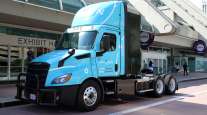
Hyzon to Pay $25 Million Fine After Settling With SEC
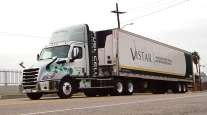
Hyzon Sends Four Hydrogen FCEV Trucks to PFG in California

Truck Maker Hyzon Raises Funds for Working Capital
- Yellow Corp.
- detention time
- Product Overview
- Battery Technology
- Fuel Cells/EKPO
- Components for Electrolyzers
- Electric Drive Units
- Drive Components
- Lightweighting
- Sealing Technology
- Metal Forming and Assembly Technology
- Tool Technology
- Elring Spare Parts
- Industrial Solutions
Electromobility
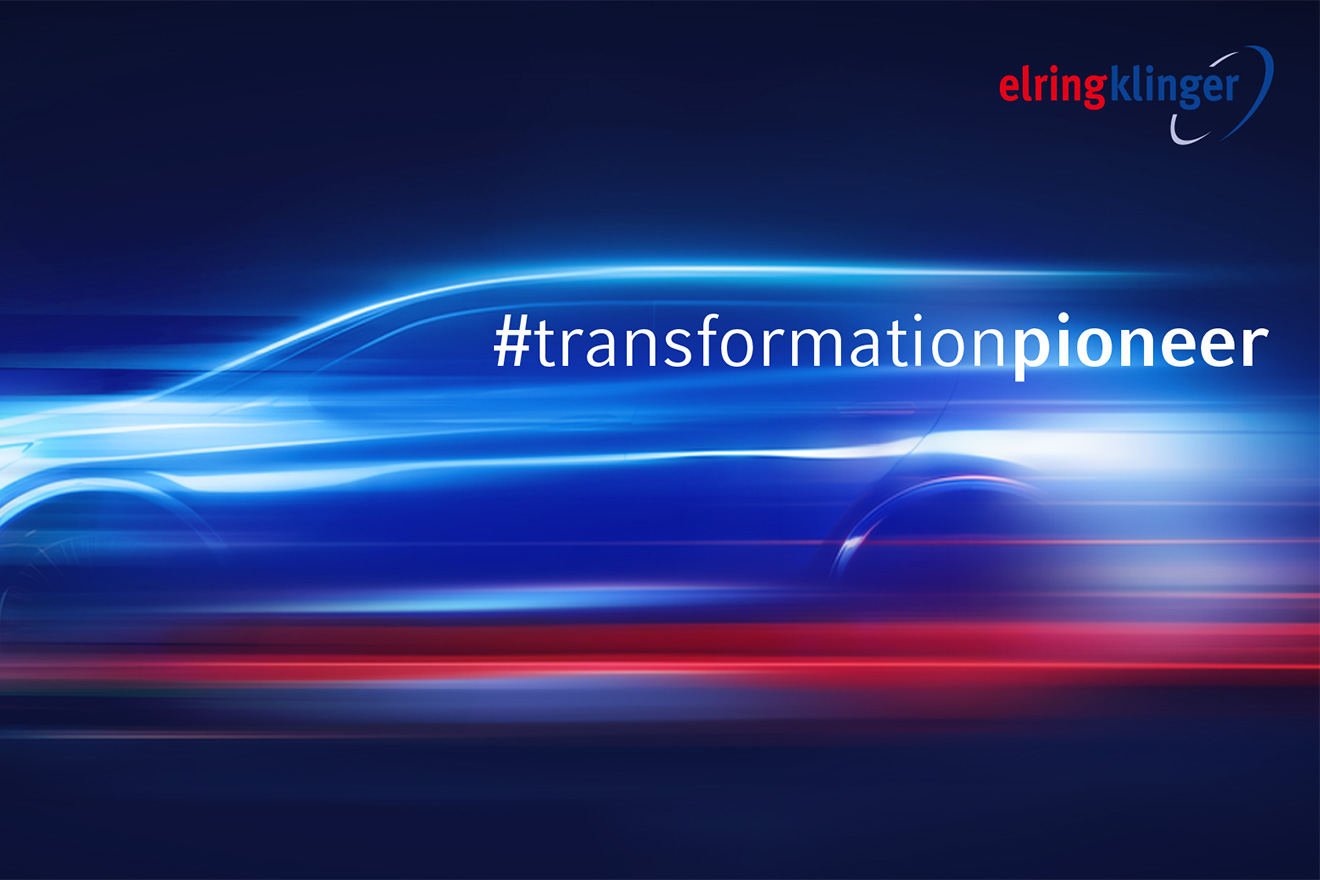
- Facts & Figures
- Group Strategy SHAPE30
- Group Structure
- Guiding Principles
- Management Board
- Supervisory Board
- Fields of Action
- Compliance-Management-System
- Reporting Channels
- Points of Contact
- Guding Principles
- Declaration of Conformity
- Corporate Governance Statement
- Compensation System
- Purchasing Program
- Terms and Conditions of Purchase
- Supplier Manual
- Initial Sampling
- Packaging Recycling
- Sustainable Supplier Management
- Become a Supplier
Whistleblowing System

- ElringKlinger as an Employer
- Professionals
- Graduates/Job Starters
- Vocational Apprenticeship
- Integrated Degree Program
Job Openings
- Application Process & Tips

- Products and Innovations
- Production and Environment
- Social Commitment
- Business Management
- Supply Chain
- Publications
- Key Figures relevant to Sustainability
- Production and environment
- Social commitment
- Products and innovations
- Corporate responsibility
- Certifications
Reporting: Sustainability report 2023

- Share Price
- Share Basic Data
- Shareholder Structure
- Financial Calendar
Financial Reports
- pulse Magazine
- Presentations / Recordings
- Announcements
- Annual General Meeting 2024
- Annual General Meeting 2023
- Annual General Meeting 2022
- Annual General Meeting 2021
- Annual General Meeting 2020
- Annual General Meeting 2019
- Annual General Meeting 2018
- Annual General Meeting 2017
- Annual General Meeting 2016
- Annual General Meeting 2015
- Annual General Meeting 2014
- Data Protection Notice for Shareholders
- IR-Newsletter

- Components for electrolyzers
- Lightweight
- ElringKlinger Engineered Plastics
- Products for Commercial Vehicles
- Trade Fair Dates & Events

- South Korea
- United Kingdom
- South Africa
- Switzerland
Select a location
- Dettingen/Erms
- Bietigheim-Bissingen
- Rottenburg/Neckar
- Geretsried-Gelting
- Mönchengladbach
- Reus (Tarragona)
- Nilüfer/Bursa
- Settimo Torinese
- Buford, Georgia
- San Antonio
- Leamington/Ontario
- Karawang, West Java
EKPO to unveil the NM20 – its most powerful fuel cell stack module yet – at IAA Transportation
EKPO Fuel Cell Technologies GmbH (EKPO), a leading full-service supplier of PEMFC stack modules and stack components, is focusing its business on hydrogen mobility in the commercial vehicle segment. Adopting the tagline “Peak performance, zero emissions,” the company will be showcasing its forward-looking performance spectrum and its extensive expertise in industrialization at IAA Transportation 2024. The world’s leading trade show for logistics, commercial vehicles, and the transportation sector is being held in Hanover from September 17 to 22, 2024.
Dettingen/Erms and Hanover, Germany, September 16, 2024 +++ One of the highlights at EKPO’s booth will undoubtedly be the latest addition to its stack portfolio, the NM20 stack module. Delivering up to 400 kW, it is EKPO’s most powerful model yet and has been designed particularly with heavy-duty applications in mind. The new stack offers a high level of efficiency, reduced hydrogen consumption, the ability to work at higher temperatures, and a long service life – all thanks to its high power density, which has been increased by more than 50% compared to the previous generations, one of EKPO’s hallmarks. Another highlight is the integrated media module, which provides all the necessary interfaces and makes the integration into customer systems and vehicles easier.
The development and commercialization of the NM20 is being supported by the German Federal Ministry for Digital and Transport and the Ministry of the Environment, Climate Protection and the Energy Sector of the state of Baden-Württemberg as part of “Hy2Tech,” the first wave of the IPCEI Hydrogen program. EKPO’s Chief Commercial Officer Dr. Stefan Dwenger explains: “The NM20 is currently in the prototyping phase, meaning that it will start being delivered to customers toward the end of 2024. We’re already in control of the entire process chain and have access to a highly automated, cost-effective manufacturing operation in line with automotive standards thanks to our existing products.” The NM20 will make its public debut at a press conference at EKPO’s booth (Hall 12, Booth C36) at 1:50 p.m. on Monday, September 16.
On board zepp.solutions B.V.’s “Europa” truck Visitors to EKPO’s booth at the trade show will also be able to see “Europa,” the fuel-cell-powered next-generation truck that was developed by the Dutch system integrator zepp.solutions B.V. The 350-bar model, which provides a 700 km range and can haul a standard trailer without any length restrictions, will be on the market before the end of the year. “Europa” also features an EKPO NM12-twin stack platform with 598 cells, which was developed for applications requiring more than 150 kW of power – primarily for heavy-duty applications, but also for a wider range of potential uses such as off-highway vehicles as well as rail, marine, and stationary solutions.
The EKPO product range encompasses customizations alongside its standard solutions. Besides stack components such as metallic bipolar plates, these also include four stack platforms – the NM5-evo, NM12-single, NM12-twin, and NM20 – with which EKPO covers a power spectrum of 15 kW to 400 kW. All of them are convincing thanks to their compact design, high power density, robustness, and high efficiency.
IAA Transportation 2024 will be all about sustainable solutions on the path to making the transportation and logistics industry carbon neutral. EKPO is actively involved in this transformation process and is making a key contribution to zero-emission mobility with its innovative fuel cell technology.
>>>>>>>>>>>>>>>>>>>>>>>>>>>>>>>>>>>>>>>>>>>>>>>>>>>>>>>>>>>>>>>>>>>>>>>>>>>>>>>> EKPO at IAA Transportation: Hall 12, Booth C36
Press Conference: New EKPO fuel cell stack NM20: "Peak performance, zero emissions" Monday, Sept. 16, 2024 | 13:50 – 14:10 hrs | EKPO Exhibition Booth >>>>>>>>>>>>>>>>>>>>>>>>>>>>>>>>>>>>>>>>>>>>>>>>>>>>>>>>>>>>>>>>>>>>>>>>>>>>>>>>
The press photos for this press release can be found on our website at www.ekpo-fuelcell.com/en/news/press-photos
NM20 – picture caption: Delivering up to 400 kW, the NM20 stack module is EKPO’s most powerful model yet.
Production – picture caption: EKPO Fuel Cell Technologies offers fuel cell stacks and components for a wide range of applications. Further information can be obtained – on behalf of EKPO Fuel Cell Technologies – via ElringKlinger AG | Strategic Communications Dr. Jens Winter Phone: +49 7123 724-88335 | E-mail: press[at]ekpo-fuelcell.com About EKPO Fuel Cell Technologies EKPO Fuel Cell Technologies (EKPO), headquartered in Dettingen/Erms (Germany), is a leading joint venture in the development and large-scale production of fuel cell stacks for CO2-neutral mobility. The company is a full-service supplier for fuel cell stacks and components used in passenger cars, light commercial vehicles, trucks, and buses as well as in rail and marine applications. Within this context, the company is building on the industrialization expertise of two established international automotive suppliers – ElringKlinger and OPmobility. The aim of the joint venture is to develop and mass-produce high-performance fuel cell stacks in order to further advance CO2-neutral mobility – whether on the road, rail, water, or off-road.
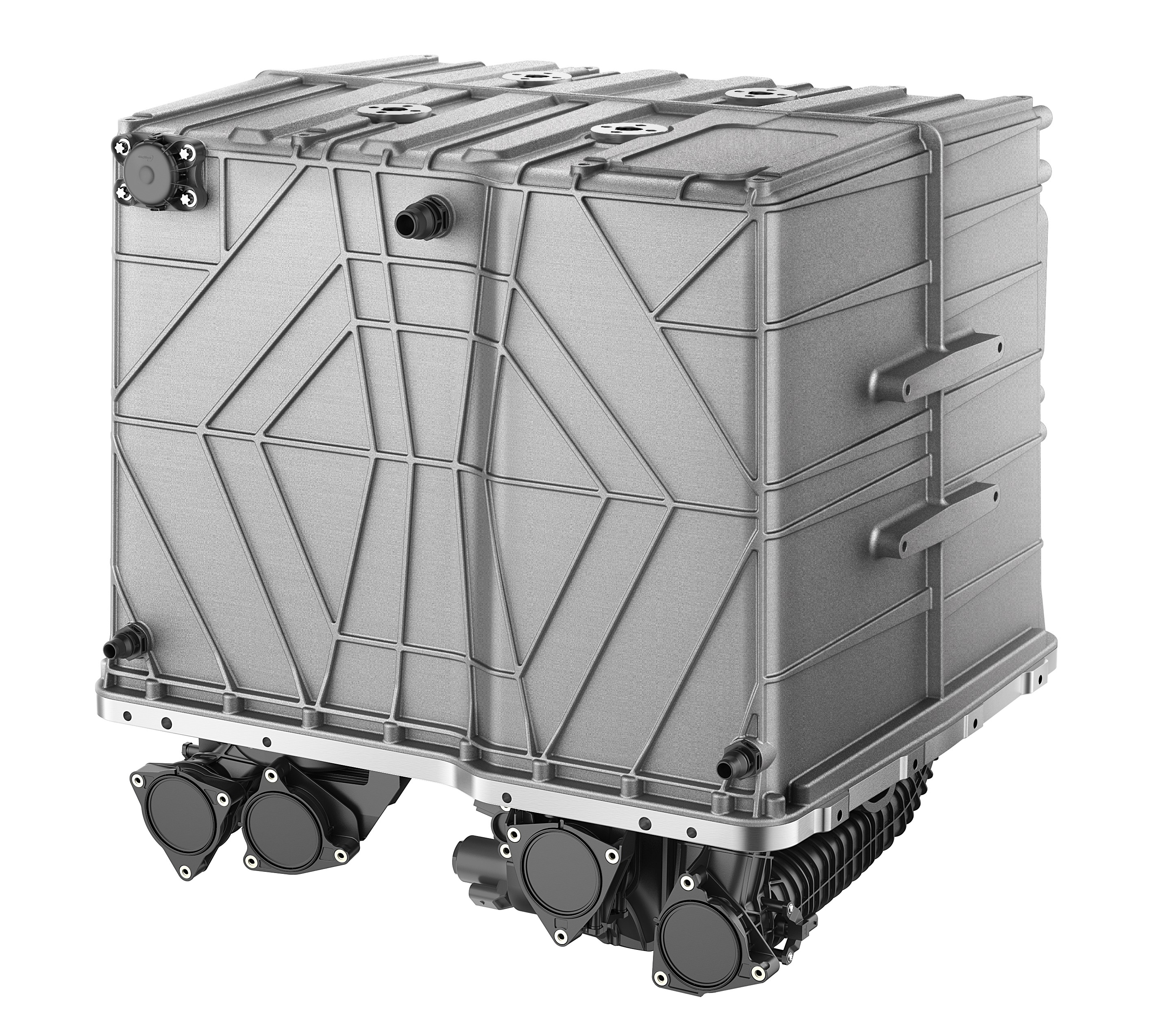
Delivering up to 400 kW, the NM20 stack module is EKPO’s most powerful model yet.
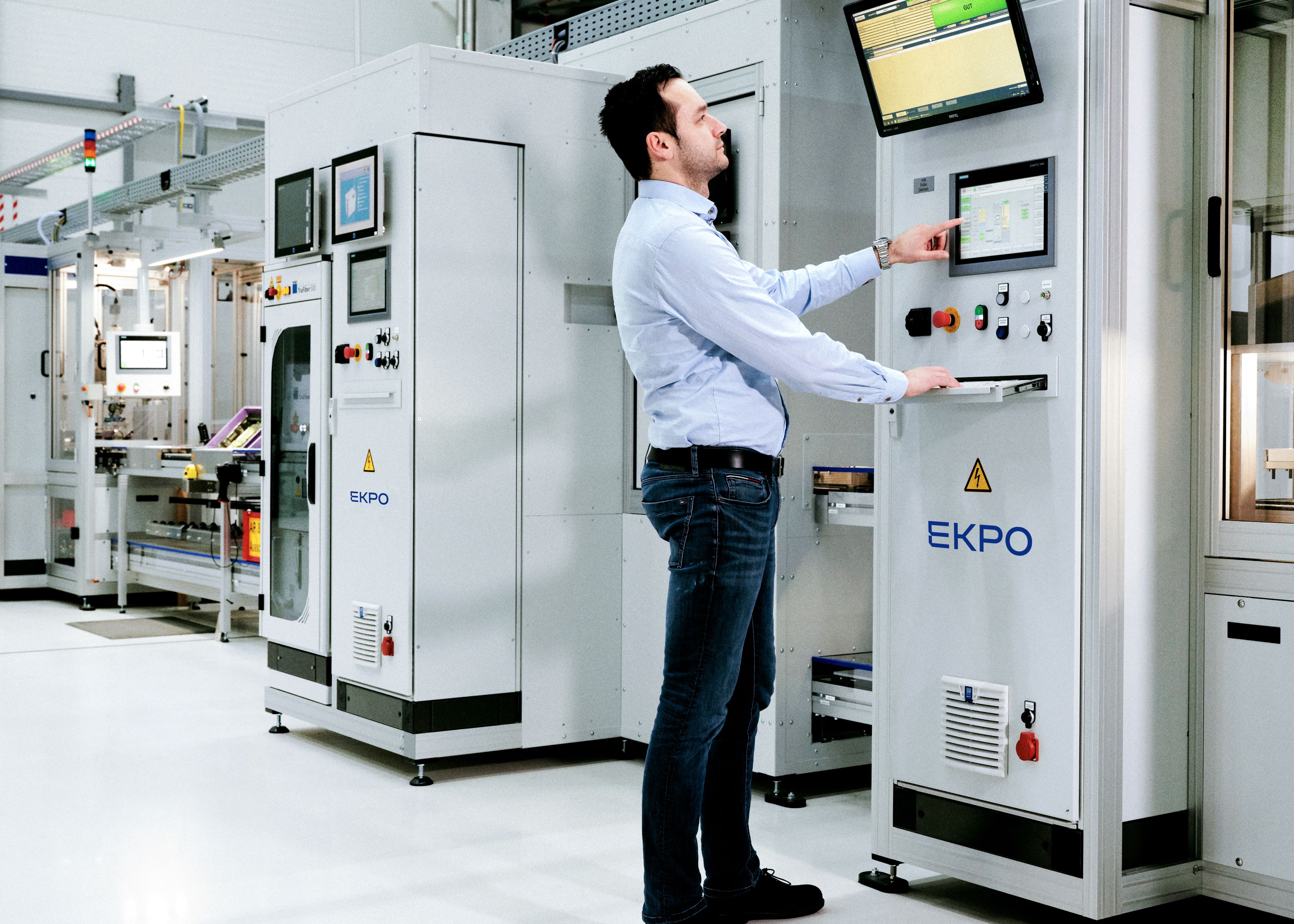
EKPO Fuel Cell Technologies offers fuel cell stacks and components for a wide range of applications.
- Press Release (16.09.2024) 482 KB
- Press Photo EKPO Fuel Cell Technologies - NM20 Fuel Cell Stack 3 MB
- Press Photo EKPO Fuel Cell Technologies - Production 2 MB
Reprinting free of charge. File copy requested. For further information please contact:
ElringKlinger AG Dr. Jens Winter Strategic Communications
Max-Eyth-Straße 2 D-72581 Dettingen/Erms Fon +49 7123 724-88335 Fax +49 7123 724-85 8335 E-Mail jens.winter[at]elringklinger.com
Everything you need to know about training, studies, careers and working at ElringKlinger.
To Instagram
Visit us on Facebook and learn more about our company and our employees.
To Facebook
Follow us on X and stay up to date on the latest company news.
Follow us on LinkedIn and stay up to date on the latest company news.
To LinkedIn
Follow us on Xing and stay up to date on the latest company news.
Press Release
- ZF expands its full-flex e-mobility portfolio with the Hydrogen Recirculation Blower for fuel cell powered commercial vehicles
- Efficiency and Performance: The Hydrogen Recirculation Blower improves efficiency and longevity of the Fuel Cell Stack
- The Hydrogen Recirculation Blower works in conjunction with ZF’s Fuel Cell Air Compressor to optimize the efficient operation of fuel cell systems
Hanover (Germany). At the IAA Transportation 2024, ZF Commercial Vehicle Solutions (CVS) division unveiled its latest addition to its e-mobility portfolio, a new Hydrogen Recirculation Blower. Designed to optimize hydrogen levels for fuel cell-powered vehicles, ZF’s Hydrogen Recirculation Blower recirculates unused hydrogen to improve hydrogen consumption and performance. Highly efficient, the system draws minimum power from the fuel cell system to reduce hydrogen usage.

The Hydrogen Recirculation Blower works in conjunction with ZF’s Fuel Cell Air Compressor, which was announced in April 2023. The compressor supplies air to the fuel cell stack, facilitating the chemical reaction between hydrogen and oxygen, and uses turbo technologies for improved efficiency. Together, these products form part of ZF’s growing Balance of Plant (BoP) portfolio, supporting the efficient operation of fuel cell systems in commercial vehicles. Similar to the Fuel Cell Air Compressor, the Hydrogen Recirculation Blower is built to be durable, throughout the lifetime of the commercial vehicle, helping to reduce its Total Cost of Ownership (TCO).
“ZF has applied its extensive expertise in system integration and air bearing systems to develop these innovative products,” says Dr. Christian Brenneke, Head of Innovation & Development at ZF's Commercial Vehicle Solutions Division. “The newly unveiled Hydrogen Recirculation Blower, combined with our fuel cell air compressor, is part of our expanding full-flex e-mobility portfolio. These innovations demonstrate how our products for fuel cell systems are driving decarbonization in a technologically open manner alongside our growing range of decarbonized technologies.“
The Hydrogen Recirculation Blower, based on the turbomachinery concept, is compact, lightweight and optimized for efficiency. Its ultra high-speed electrical motor can reach up to 100,000 RPM, using air bearing technology to eliminate the need for lubrication and prevent contamination of the fuel cell stack. This ensures optimal efficiency and high media mass flows. Additionally, the system also includes an integrated inverter that supports 800 V high voltage systems.
Hydrogen recirculation is vital for the longevity and efficiency of the fuel stack. Leading in the industry, ZF’s Hydrogen Recirculation Blower solution efficiently manages water and inert gases in the anode path. Thanks to the use of the patented electric media-gap motor technology, the water separator will be integrated directly in the device, and the need for active cooling is eliminated. This offers great advantages in packaging and less complexity in the system assembly.

Frank Discher
+49 7541 77-960 770

Florian Laudan
+49 151 200 002 76

IMAGES
VIDEO
COMMENTS
The 290-footer is also the largest yacht built by Feadship to date, meaning it could easily hold the requisite fuel cells, battery banks, and hydrogen tanks. For the unversed, fuel cells are a ...
This isn't the first time we've seen fuel cells pop up in superyacht design. In September 2019, Sinot unveiled the radical 360-foot concept Aqua which was fitted with a hydrogen propulsion system.
Sclupted in steel and aluminum, Feadship's Project 821 is a yacht with an eye on the future. Feadship. Feadship R & D found that no regulations for hydrogen storage and fuel-cell systems existed ...
That's the idea behind the new Project 821, billed as the world's first hydrogen fuel cell superyacht. Announced over the weekend by Danish shipyard cooperative Feadship, Project 821 arrives ...
The tanks, the 16 fuel cells, the switchboard connecting them to the D.C. grid, and the vent stacks for the water vapor added 13 feet (4 meters) to the original LOA. The Feadship yacht Project 821 therefore grew to just shy of 390 feet (119 meters). Even with this massive LOA, the Feadship yacht Project 821 isn't large enough to accommodate ...
Genevos HPM-8 hydrogen fuel cell. Successful solo offshore racer Phil Sharp is at the forefront of developing hydrogen fuel cells for yachts. His 8kW HPM-8 (Hydrogen Power Module) is of a size ...
The Sea Change is equipped with hydrogen fuel cells that power its all-electric motors. These cells allow the vessel to travel up to 300 nautical miles (345 miles) at speeds of up to 15 knots (17 ...
The fuel cell system has the potential to provide the vessel with approximately 600 miles of range using the 14kg of hydrogen stored on-board, as well as additional power being supplied from solar panels on the boat's roof to the 22kWh battery system.
The Italian yacht builder, which is no stranger to innovation, has announced that it will deliver a 164-footer equipped with hydrogen fuel cells as soon as 2024. Sanlorenzo's CEO Massimo Perotti ...
But how do fuel cells work onboard a ship, boat, or ferry? Hydrogen fuel cells are compatible with modern electric and hybrid architectures - and they generate the electricity that powers the vessel. Like batteries, they produce electricity, but with fuel cells, hydrogen fuel is the energy carrier - meaning the power system will produce ...
"The size of the proposed yacht - 100-metres-plus - made it a good candidate to explore pure green hydrogen as the fuel-cell source," a Feadship statement reads. "Even a yacht the size of Project 821 cannot carry enough liquid hydrogen to power a crossing, but Feadship could impact a yacht's carbon footprint where it is largest ...
By Emma Coady. May 13, 2024. Feadship's Amsterdam shipyard Project 821, the world's first hydrogen fuel-cell superyacht, has been launched as part of the company's quest to develop "net zero" yachts by 2030. The revolutionary yacht is designed by RWD along with the owners' representation by Edmiston. Above: Feadship's largest yacht in the shipyard.
Hydrogen fuel cells have been hailed as the future of green yachting, but it's a little more complicated than that, as Sam Fortescue discovers. Humanity had to wait until 1965 before someone at Siemens thought of using a hydrogen fuel cell to drive a boat round a pond in Bavaria. We'd known of its potential since Sir William Grove built a ...
The fuel cell will be flanking conventional generators and represents a major step towards an emissions-free superyacht. The new technology should make it possible to anchor emission-free for 15 days or cruise 1000 miles at a slow speed. "My grandfather built the world's first motorboat in 1886, my dream is to be the first to build a yacht ...
Using a 350-bar system, the weight of the fuel cell and the hydrogen storage system still comes in below that of a traditional diesel set-up, but it requires more volume and it costs more. Using gaseous hydrogen as a fuel leads French marine fuel cell developer EODev to be cautious about marine applications.
17 Apr 2023. Feadship has unveiled that construction on its first fully certified liquid hydrogen fuel-cell superyacht has now begun. Feadship Director and Royal Van Lent Shipyard CEO, Jan-Bart Verkuyl, announced the news on the yard's social media channels over the weekend. Renowned for its dedication to sustainable shipbuilding, green company ...
Feadship's Project 821 uses hydrogen fuel cell technology to provide clean, emission-free power to ...[+] the yacht in certain situations Headship. Now that Project 821 has emerged from a massive ...
Read More / Feadship announces landmark launch of fuel-cell powered 119m superyacht Project 821. This concept is predicted to be "30 per cent more efficient than a typical 75-metre yacht", according to Feadship, with dual shafts, propellers, rudders and an underwater profile tailored to produce less wake.
The boat produces all the energy it needs to sail, and it does that through three different methods. ... the cargo ship will also run on hydrogen fuel cells provided by car companies like Toyota ...
Hynova Yachts, based in France, is among the first builders to embrace hydrogen as a source of fuel, and its prototype 40-foot powerboat plans to use Toyota's REXH2 fuel cell for power. With twin 150-kW electric engines, the Hynova 40, an open-design yacht tender, projects to hit a top speed of 25 knots and cruise at 15 knots.
Hydrogen fuel cells are clean burning energy sources with a relatively high power-to-weight ratio, making them ideal for use in yachts where weight is a critical factor. Increase in the usage of hydrogen and hydrogen-based fuels can prevent nearly 60 gigatonnes of CO2 emissions by the middle of the 21 st century, directly addressing critical ...
The Hydrogen Propulsion. AQUA has large hydrogen capacity (two 28-ton tanks) for an operating range of 3,750 nautical miles at 17 knots. The proton exchange membrane (PEM) fuel cells generating power of four MW to support the hotel functions and the electric engines (one MW each) with contra-rotating propellers and Voith Schneider propellers.
The fuel-cell system is much larger and more complex for a superyacht than a smaller boat. Lürssen said it began to develop the system in 2008. Related Stories
The yacht has been commissioned by a "pioneering and technology-driven client" and will feature fuel cell technology driven by hydrogen, which is continuously reformed from methanol. Italian shipyard Baglietto also announced at the 2021 Monaco Yacht Show that it would be investing in similar tech in a project it is calling BZERO. Fabio ...
Hyzon began series production of its 200-kilowatt Class 8 hydrogen fuel cell electric truck Sept. 16, the Bolingbrook, Ill.-based company said.
2.3. Description of solid oxide fuel cells. Unlike PEMFCs used for power generation in automobiles, SOFCs made from solid ceramics operate at high temperatures, ranging from 700°C to 1000°C (Golkhatmi, Imran Asghar, and Lund Citation 2022).These components can provide high electrical efficiency and offer advantages due to electrolyte management problems and battery corrosion.
A hybrid energy storage system (HESS) composed of hydrogen fuel cells and batteries is a typical energy storage combination used to support the smooth operation of microgrids, ... Han, J.; Charpentier, J.; Tang, T. An Energy Management System of a Fuel Cell/Battery Hybrid Boat. Energies 2014, 7, 2799-2820. [Google Scholar]
Approximately 10 billion kilograms of hydrogen is produced in the U.S. every year—the equivalent of 10 billion gallons of fuel. Powering U.S. freight rail required 3.1 billion gallons of fuel in ...
EKPO Fuel Cell Technologies GmbH (EKPO), a leading full-service supplier of PEMFC stack modules and stack components, is focusing its business on hydrogen mobility in the commercial vehicle segment. Adopting the tagline "Peak performance, zero emissions," the company will be showcasing its forward-looking performance spectrum and its extensive expertise in industrialization at IAA ...
ZF expands its full-flex e-mobility portfolio with the Hydrogen Recirculation Blower for fuel cell powered commercial vehicles Efficiency and Performance: The Hydrogen Recirculation Blower improves efficiency and longevity of the Fuel Cell Stack The Hydrogen Recirculation Blower works in conjunction with ZF's Fuel Cell Air Compressor to optimize the efficient operation of fuel cell systems ...